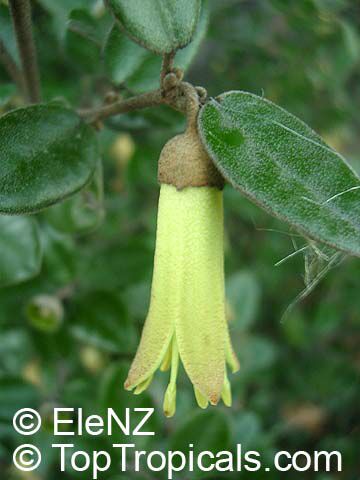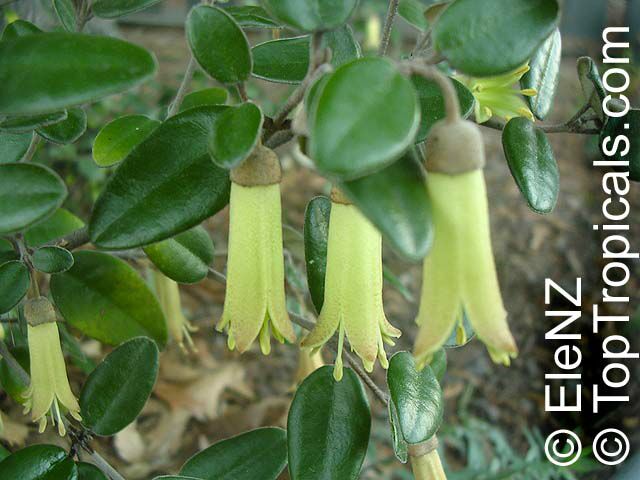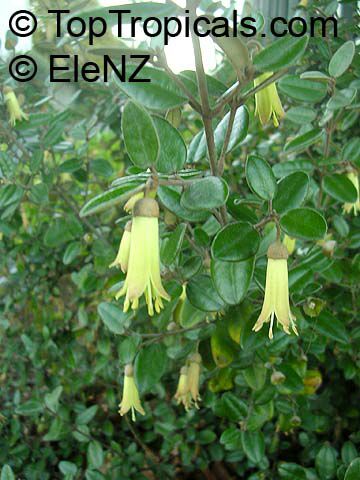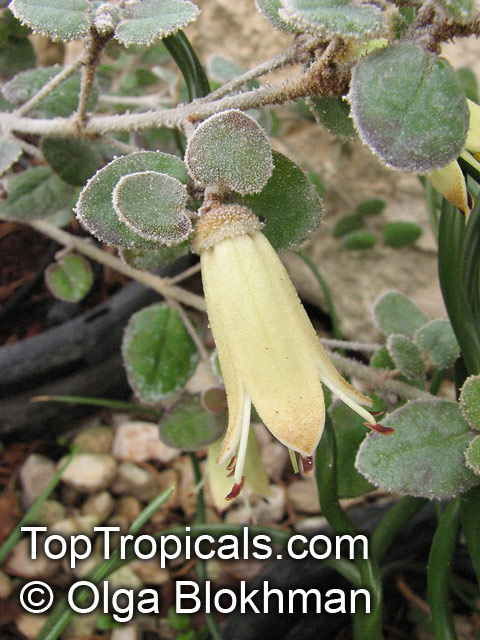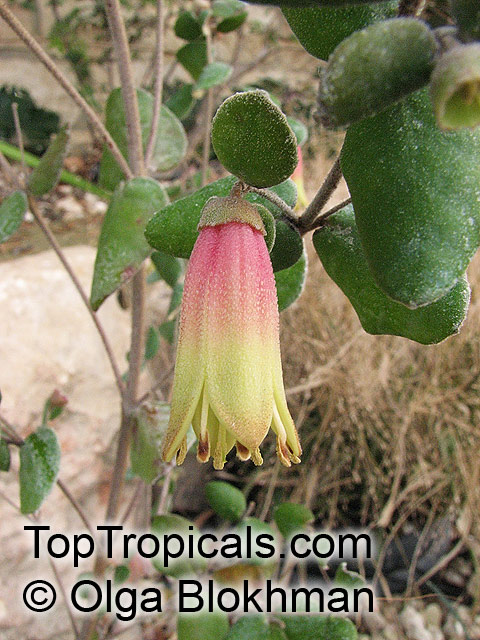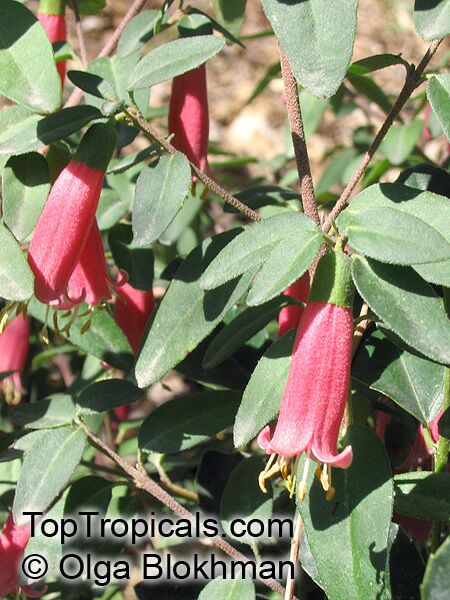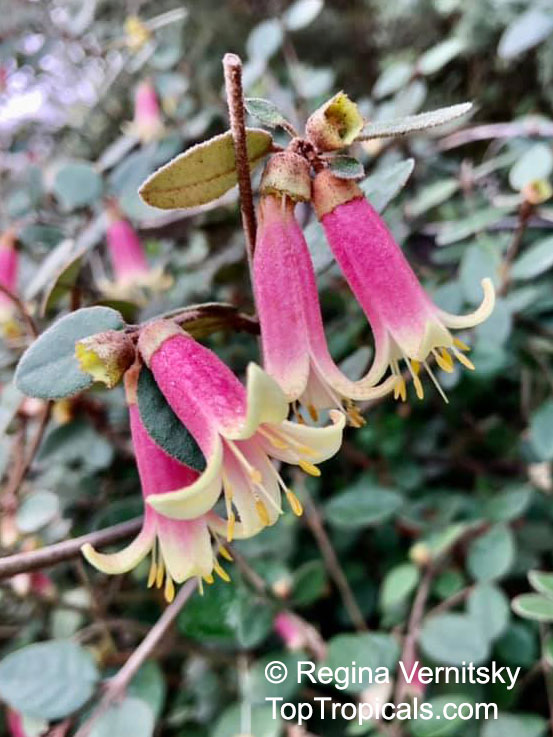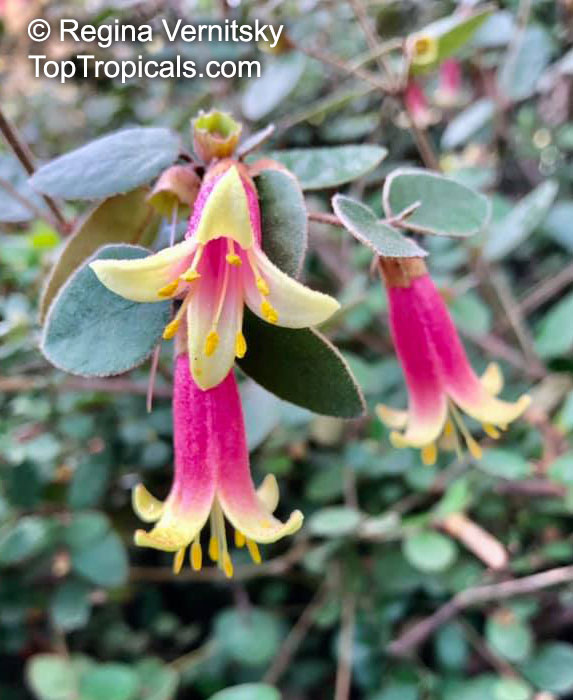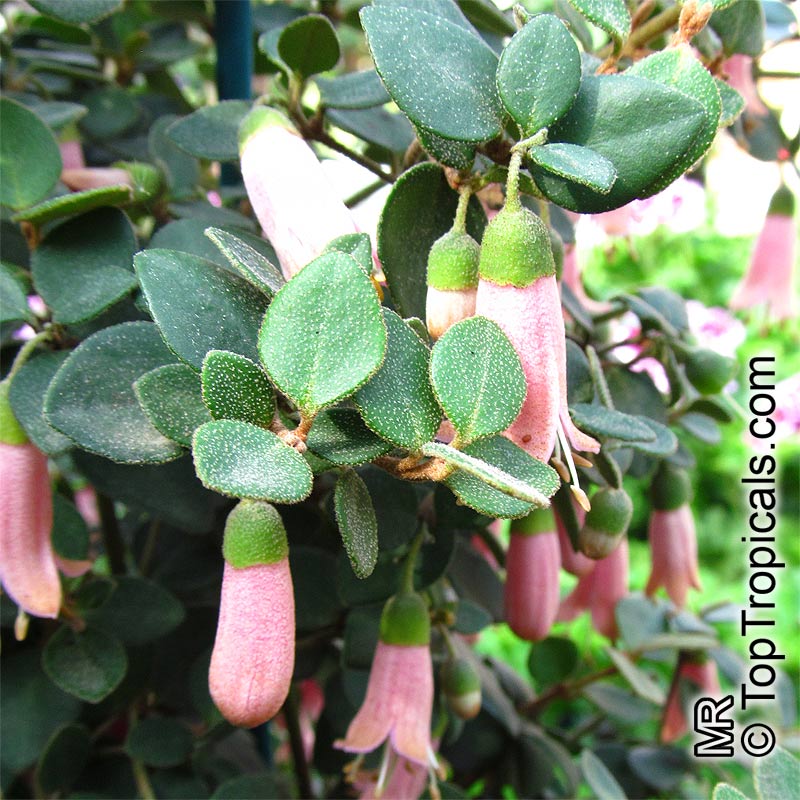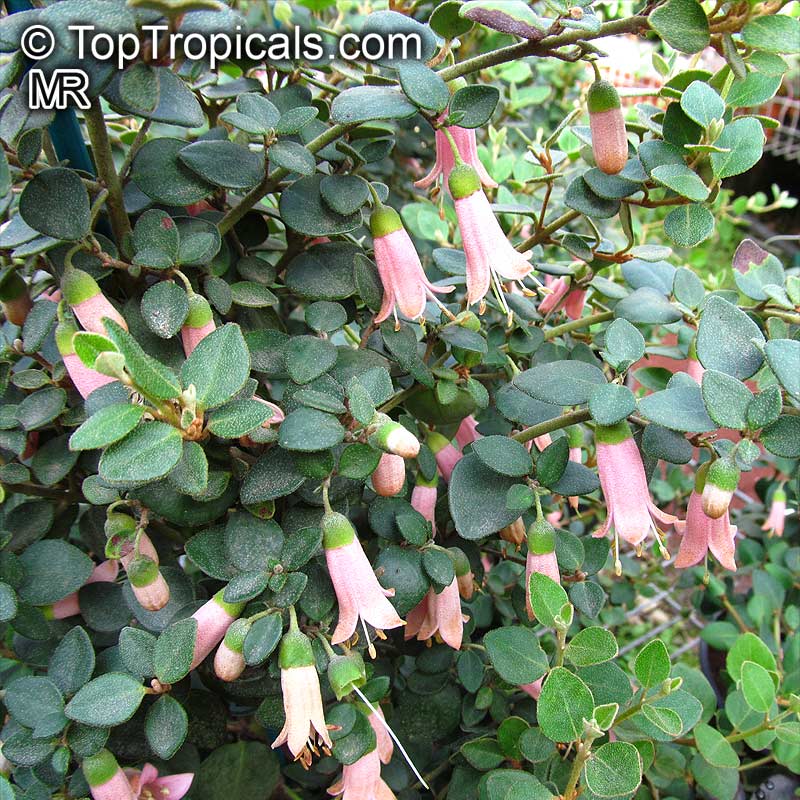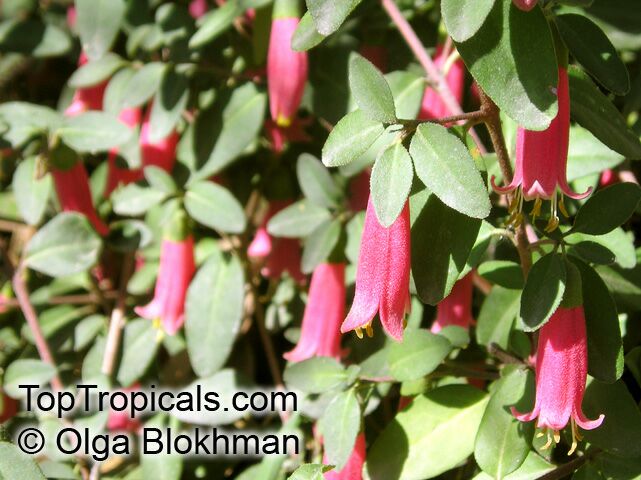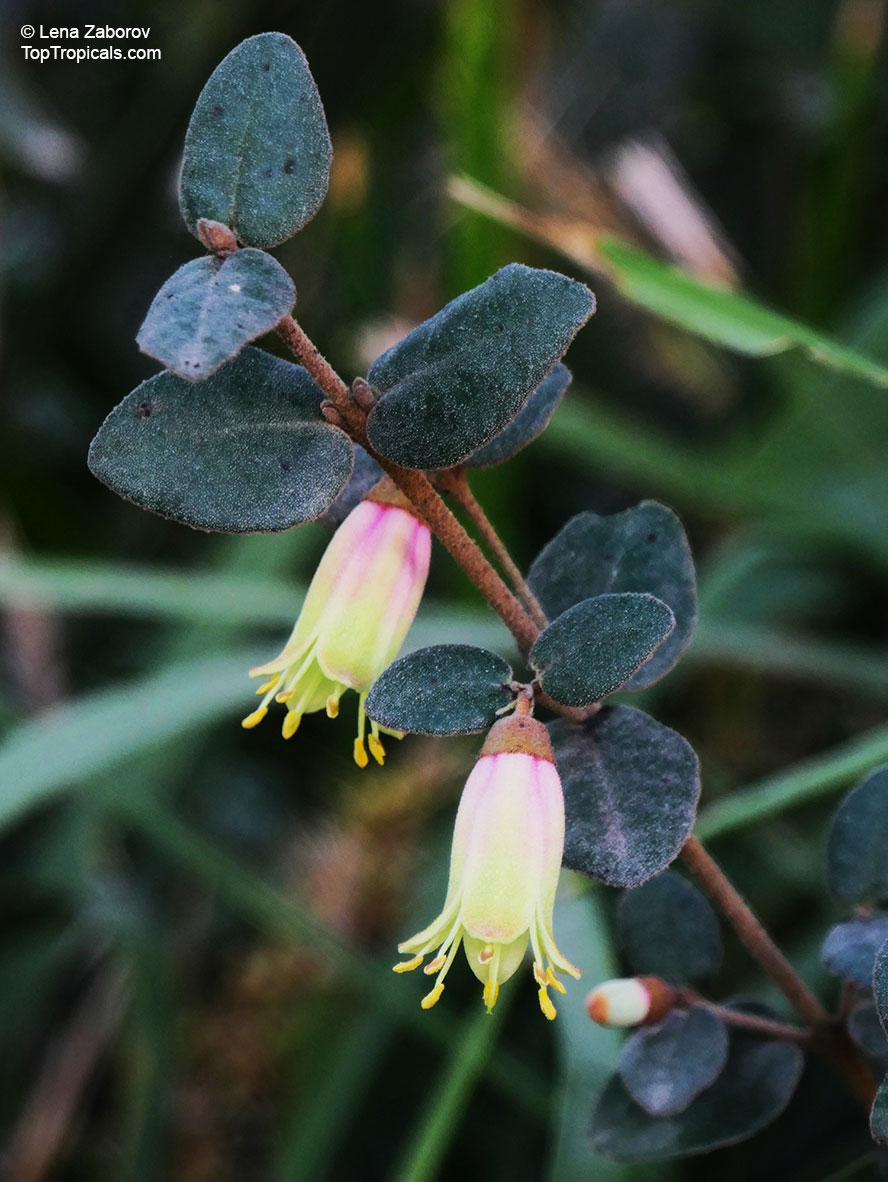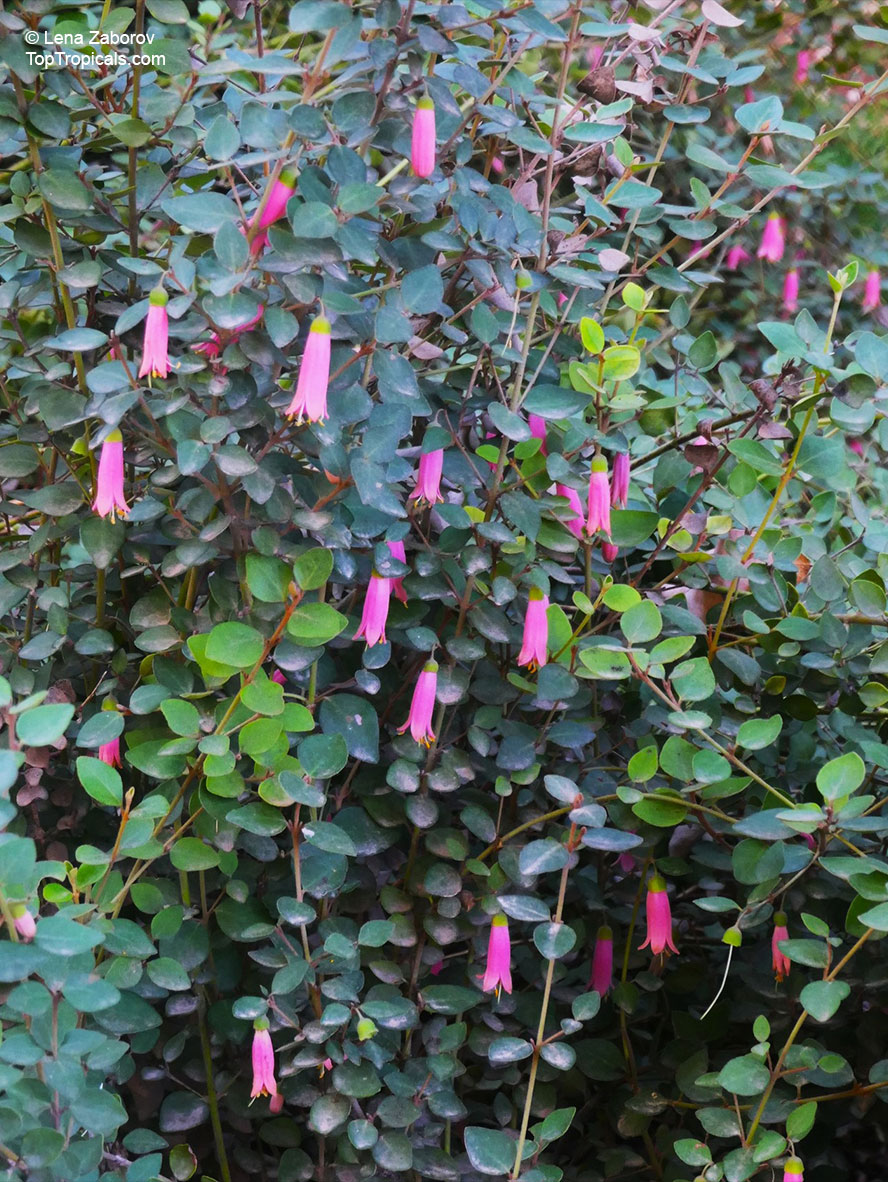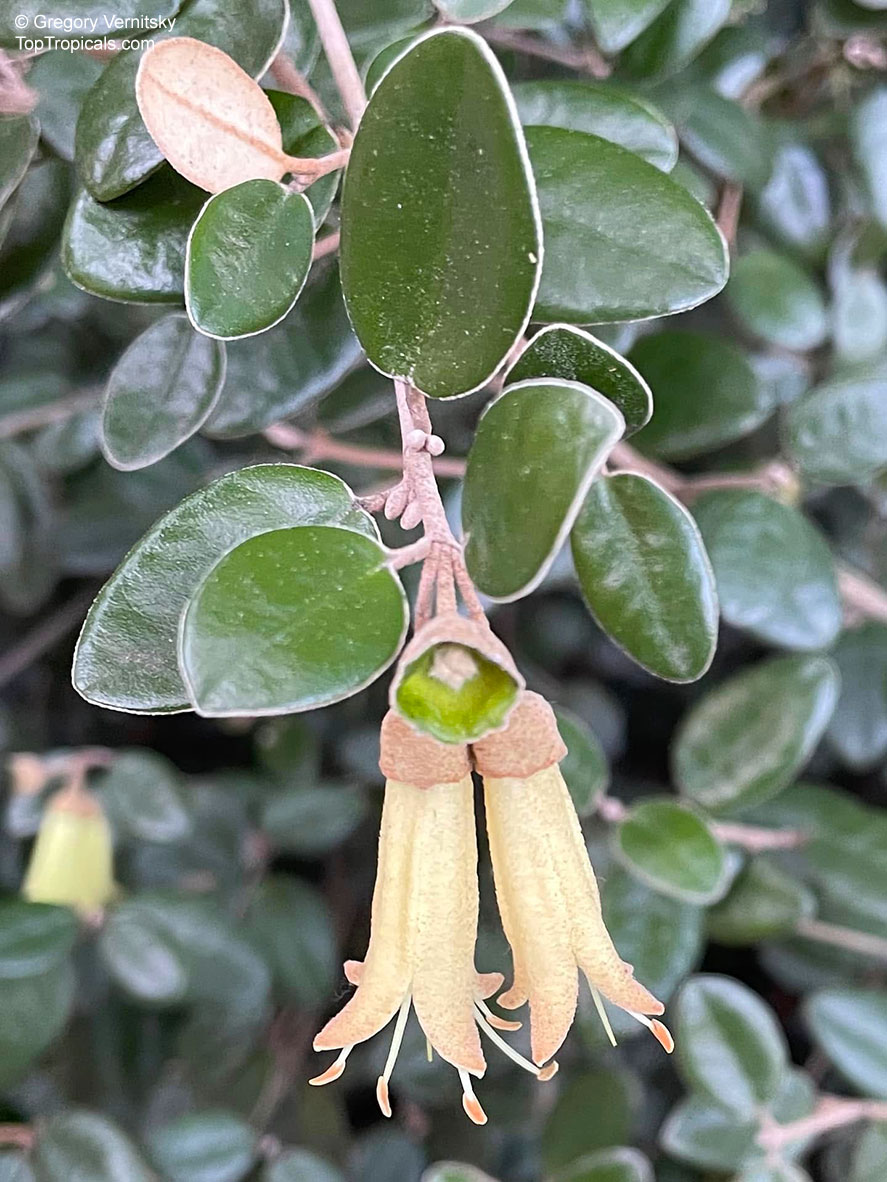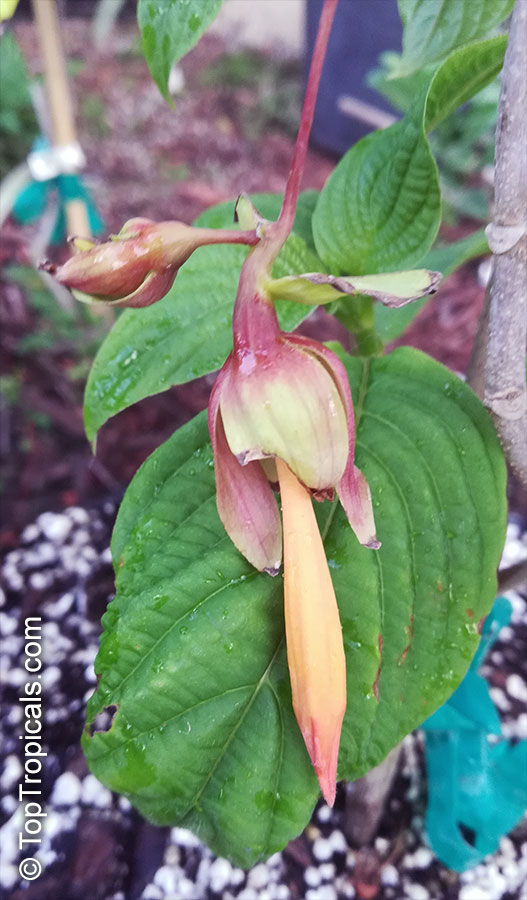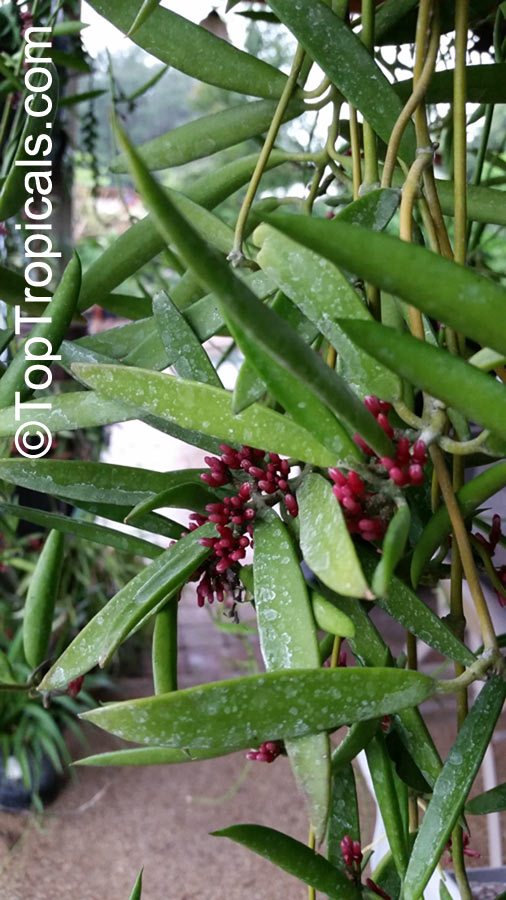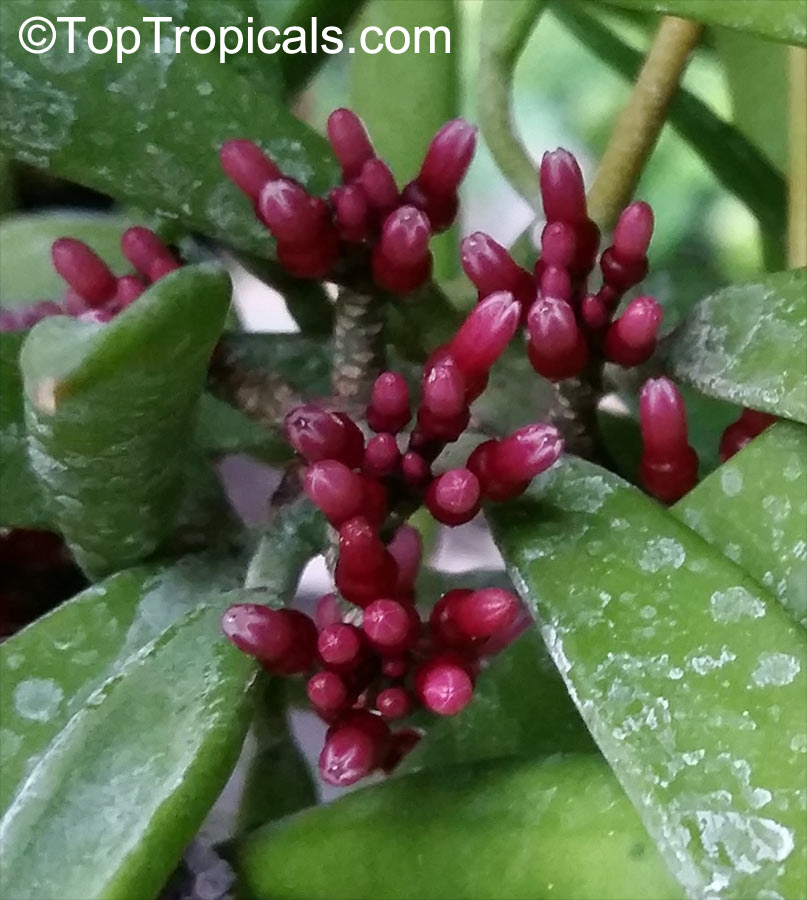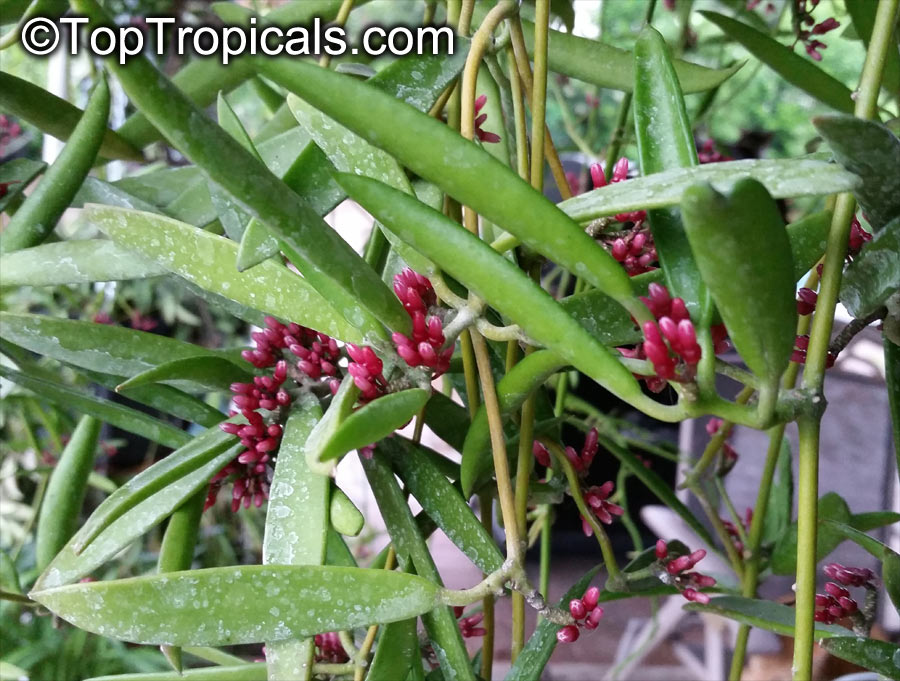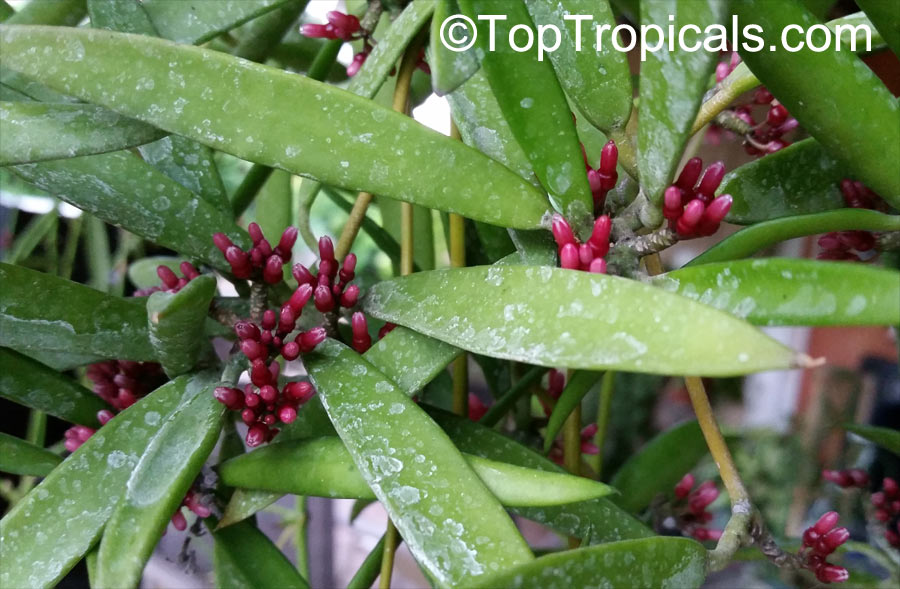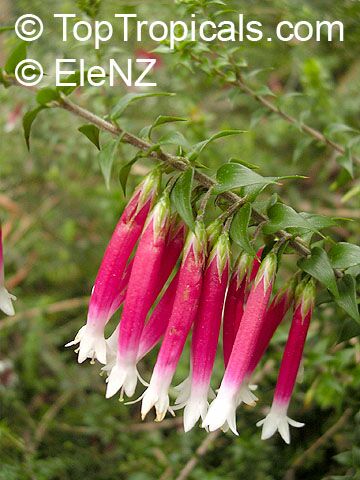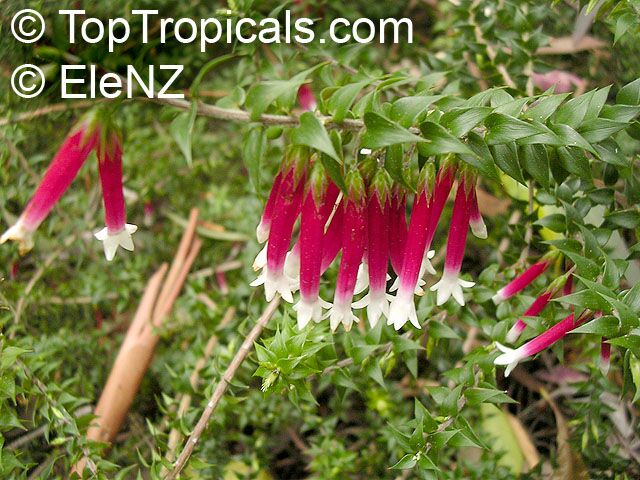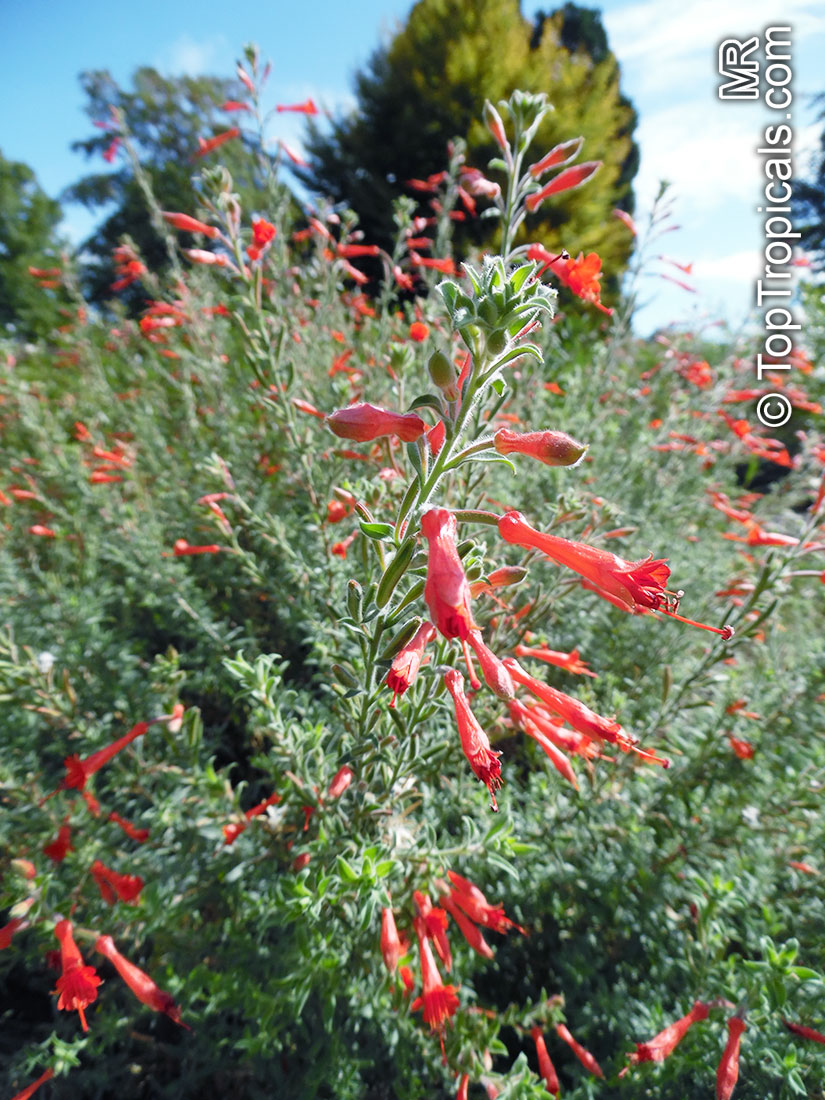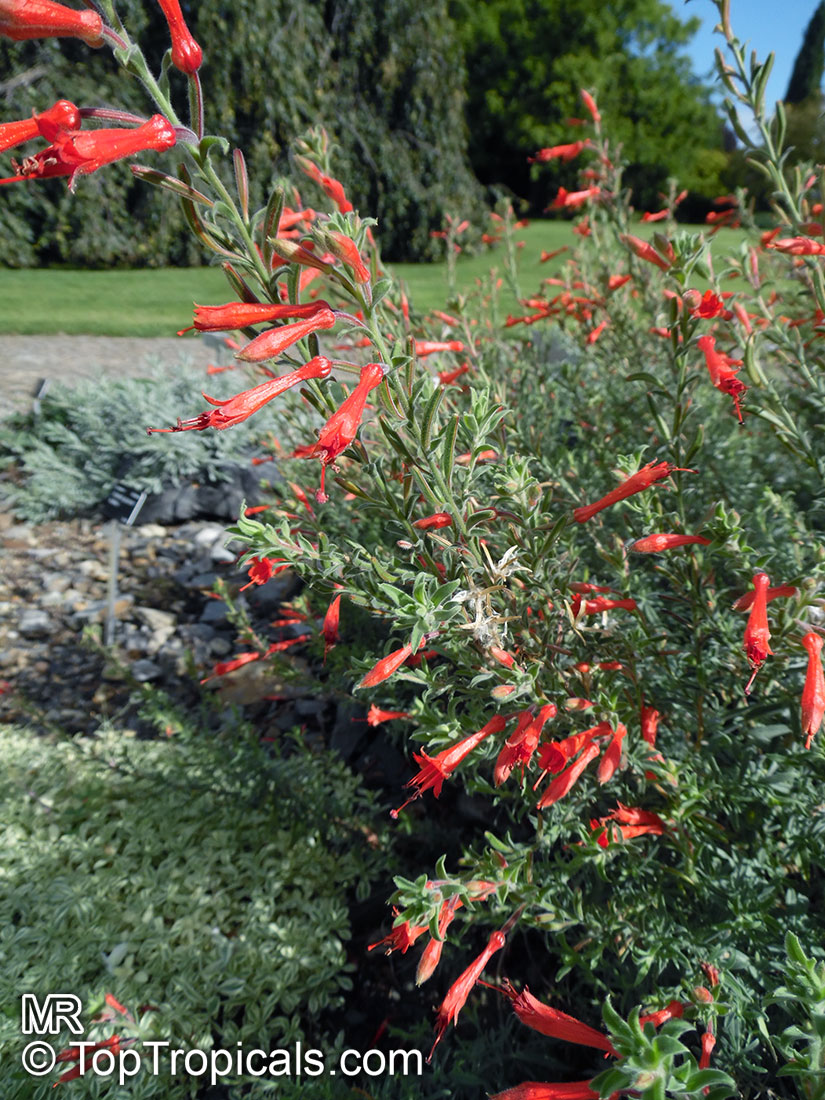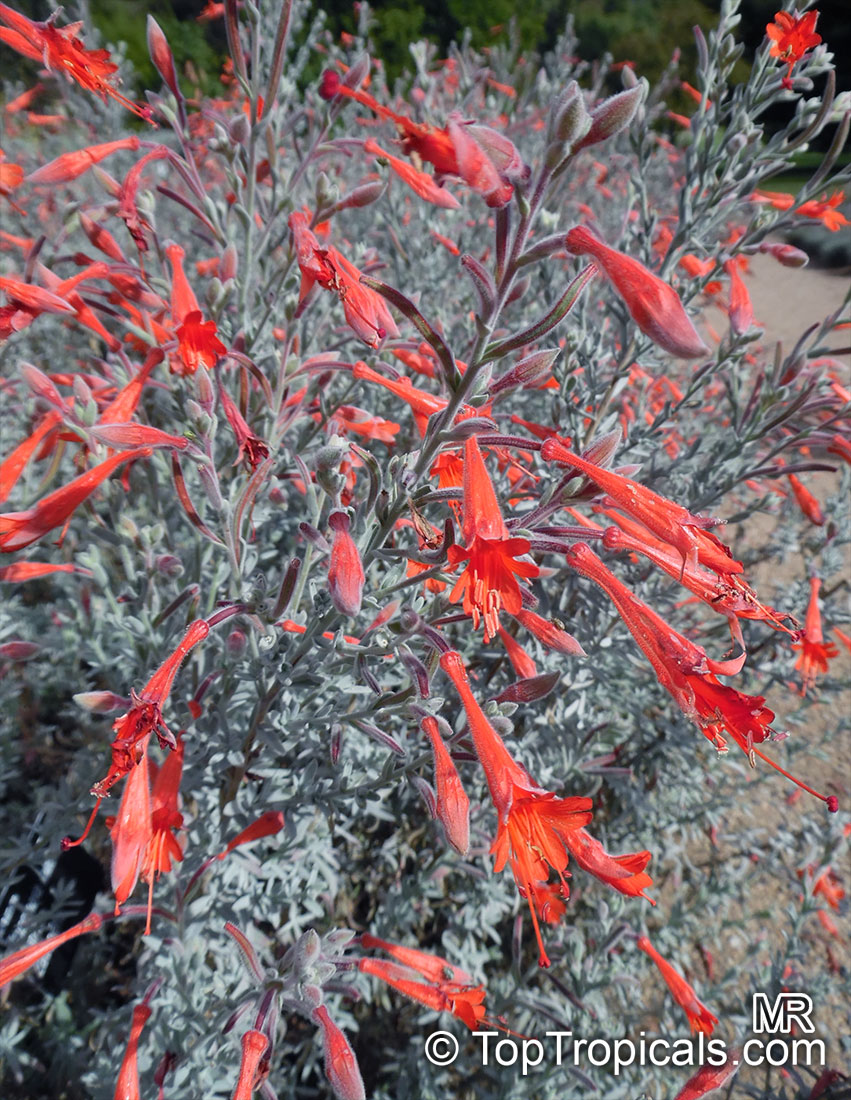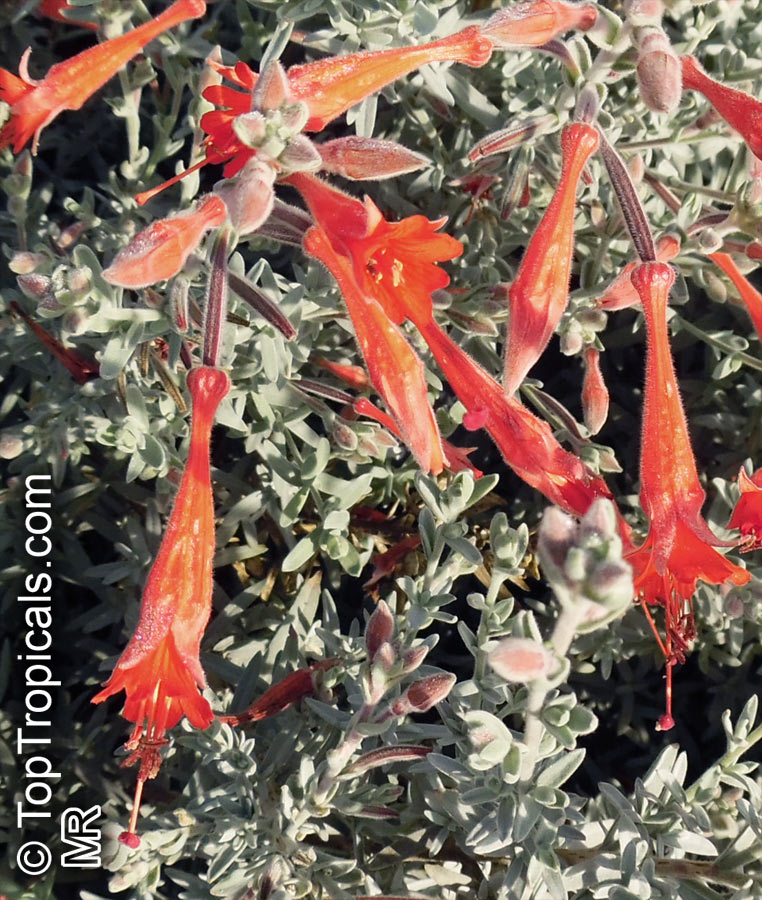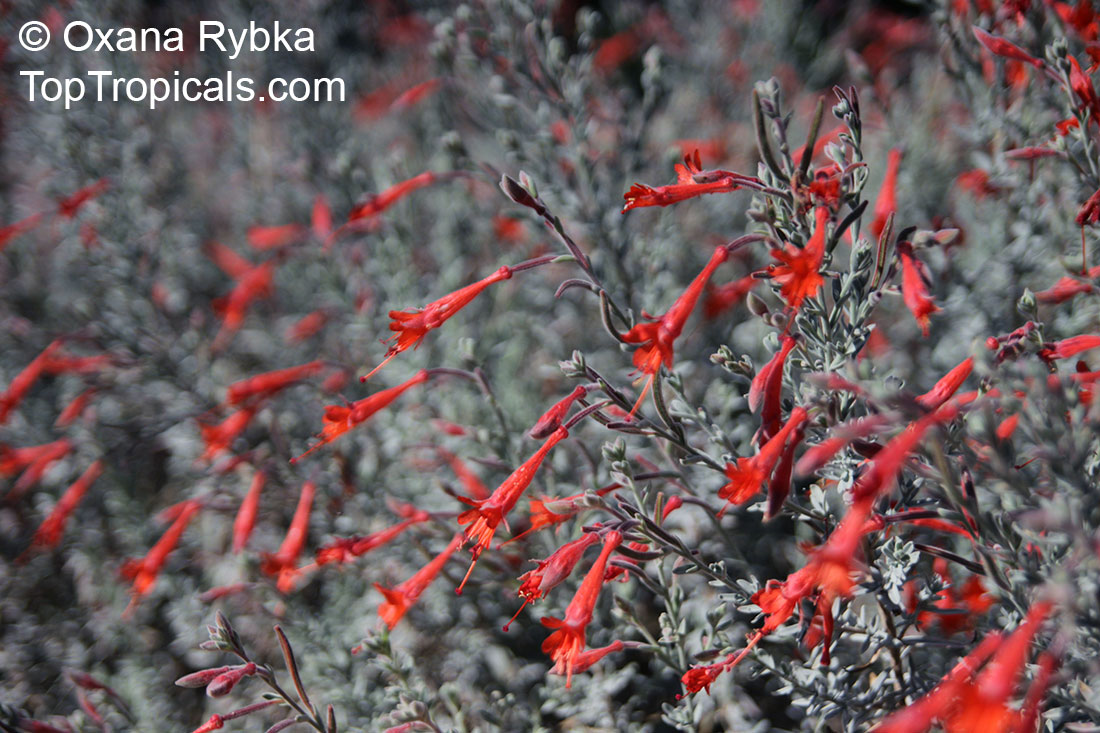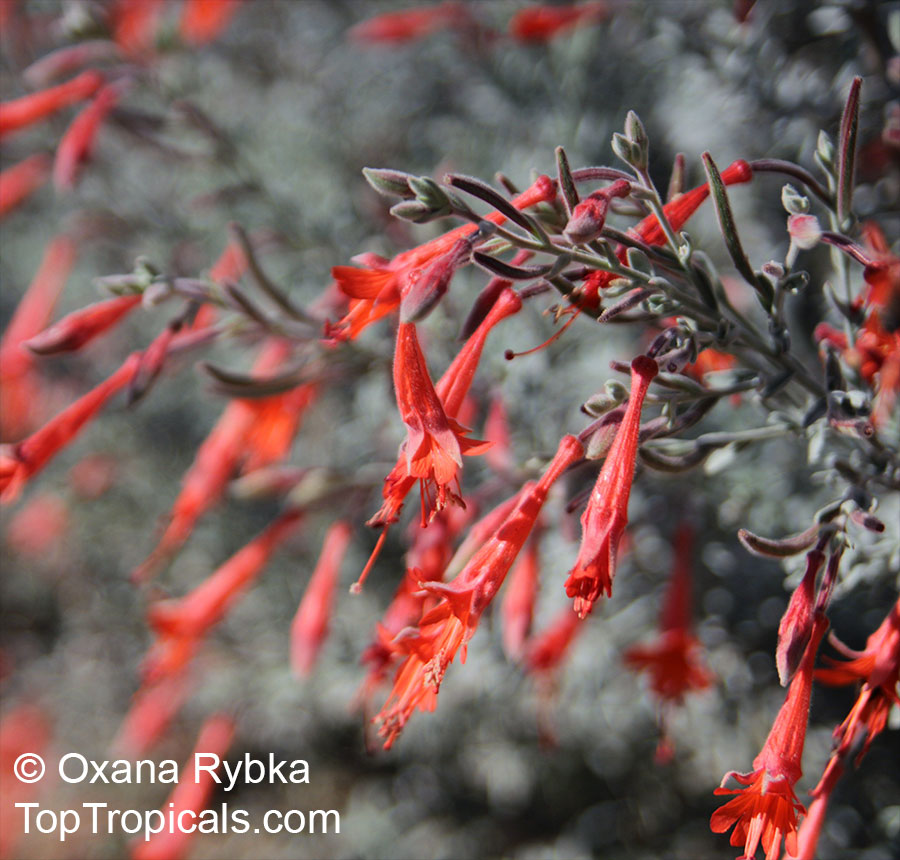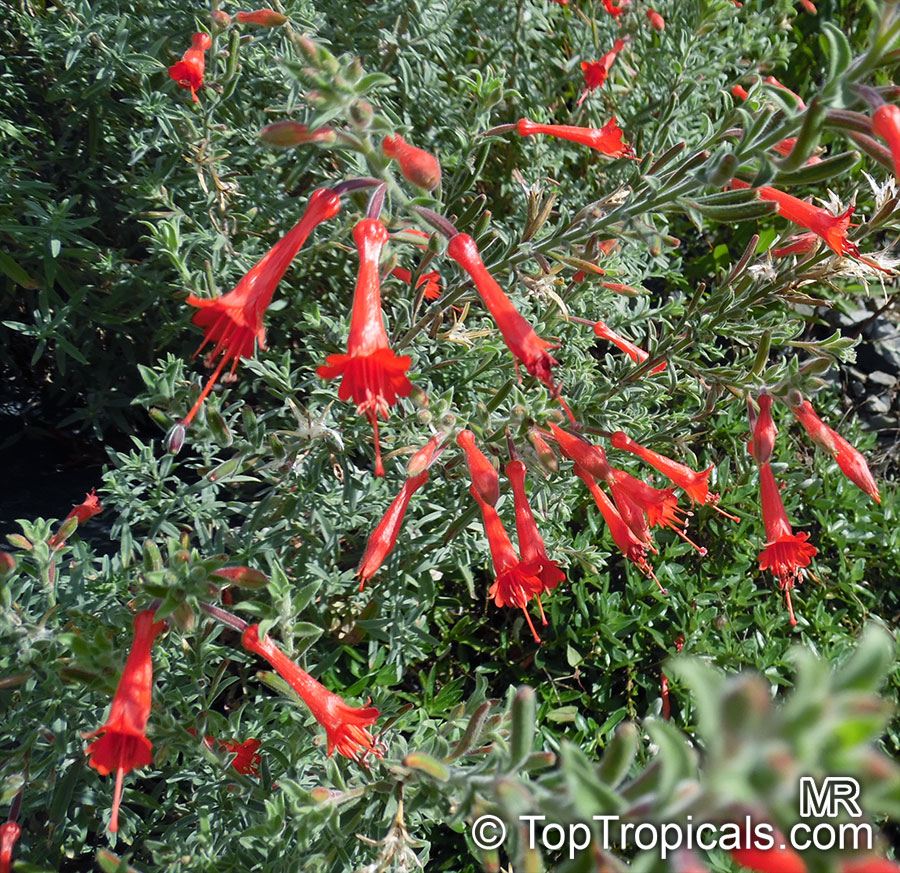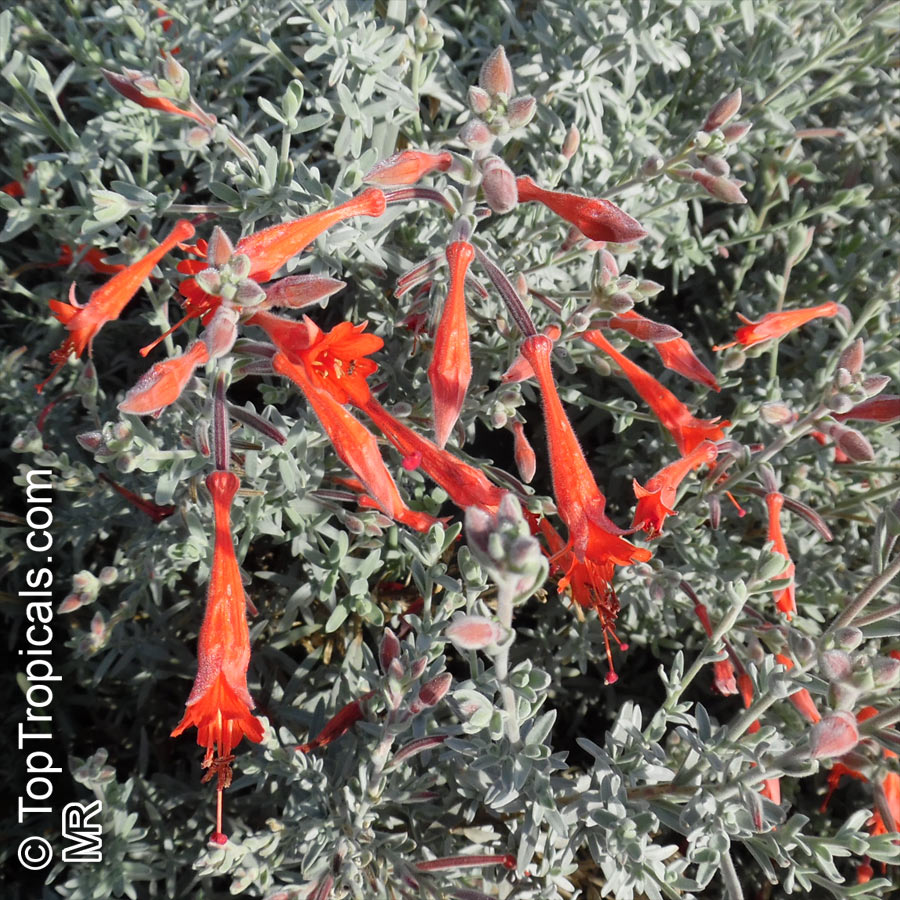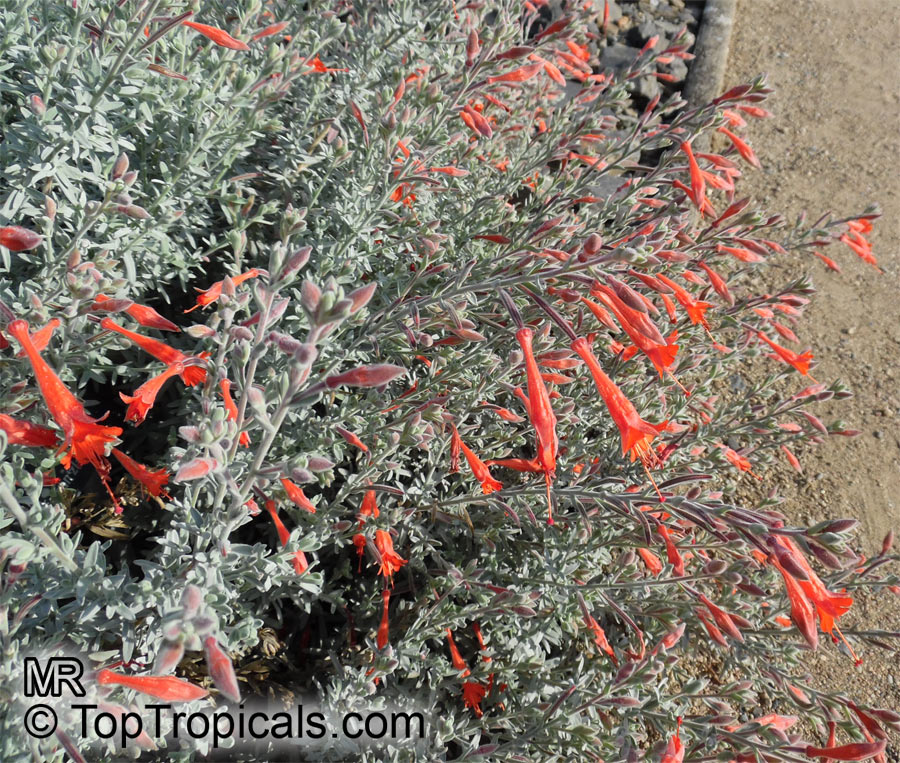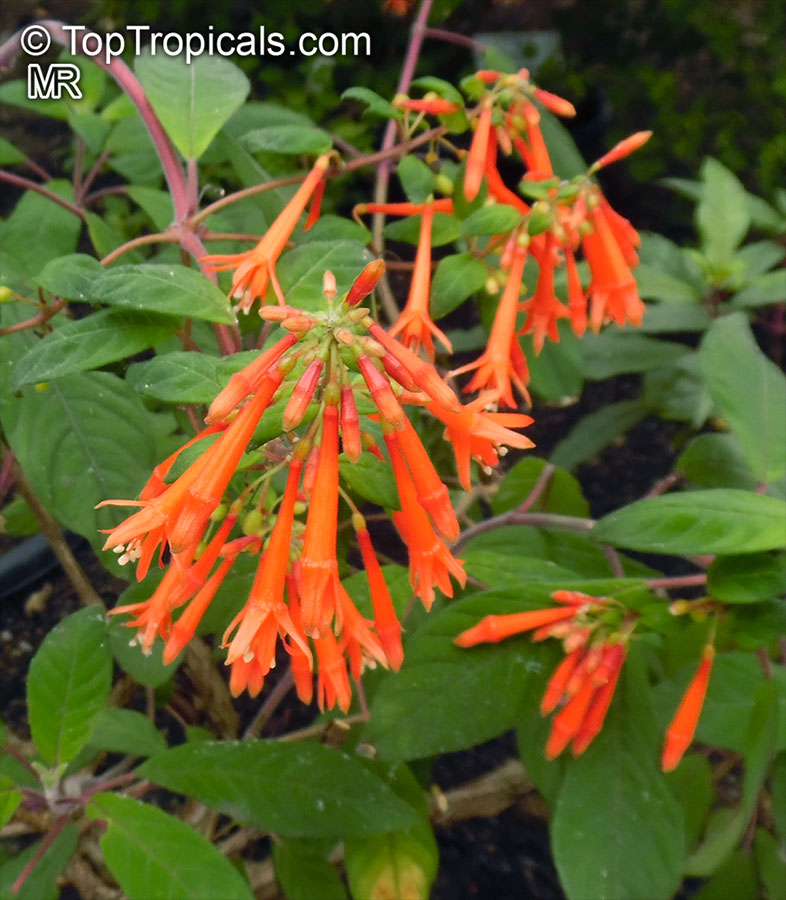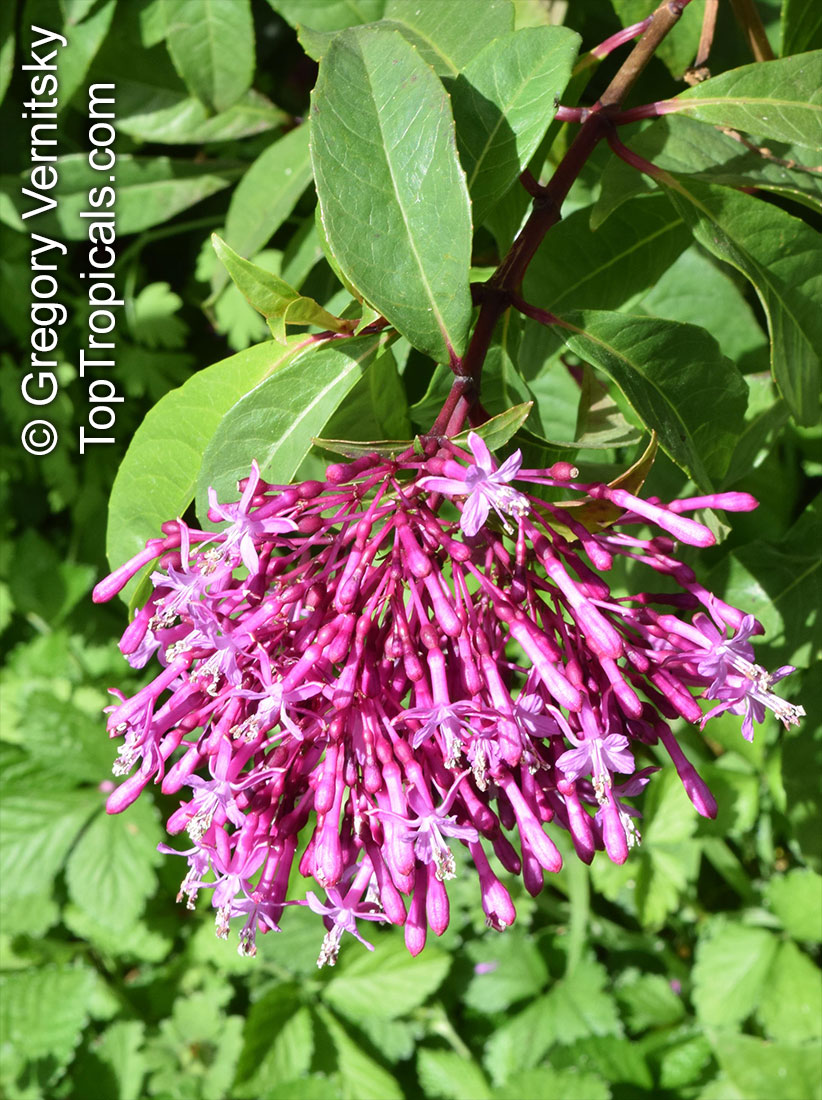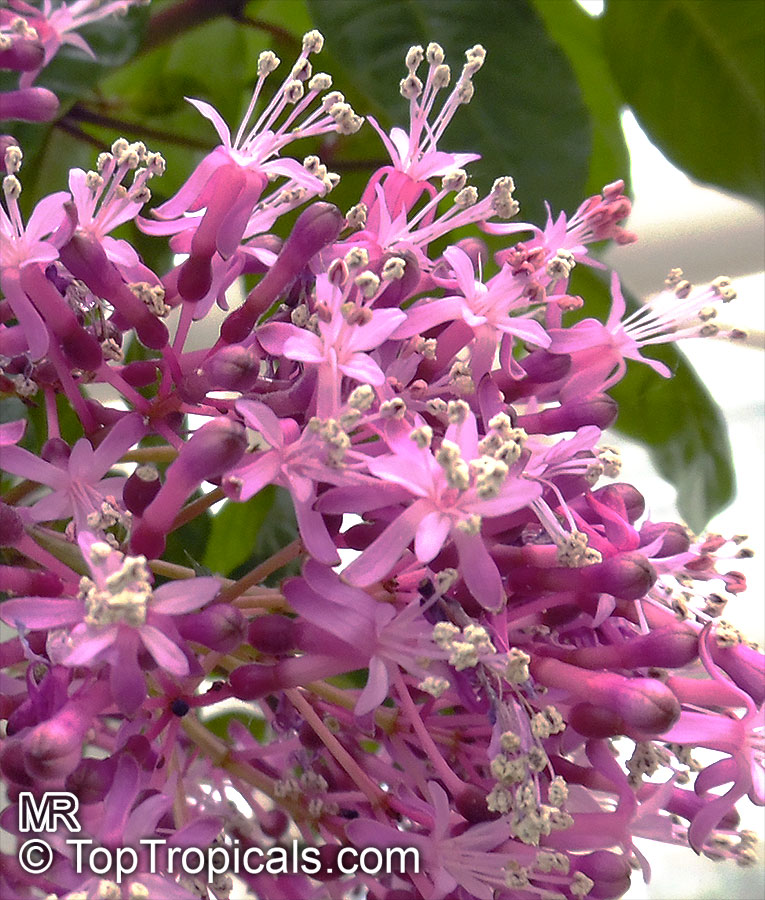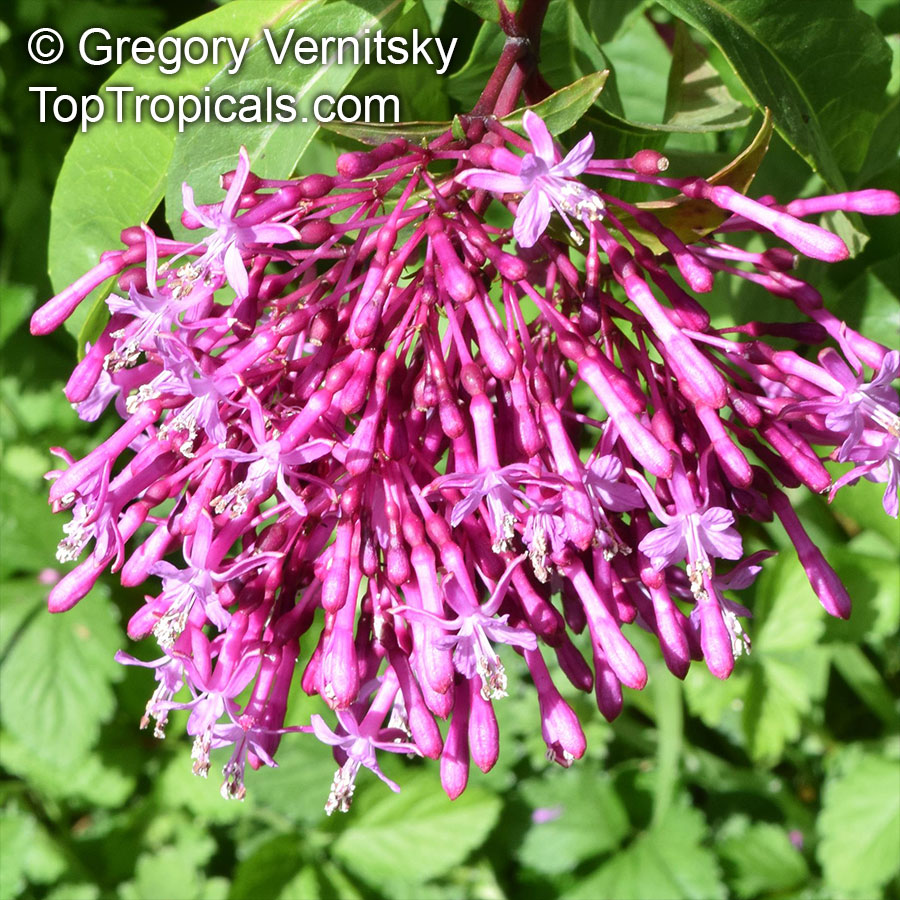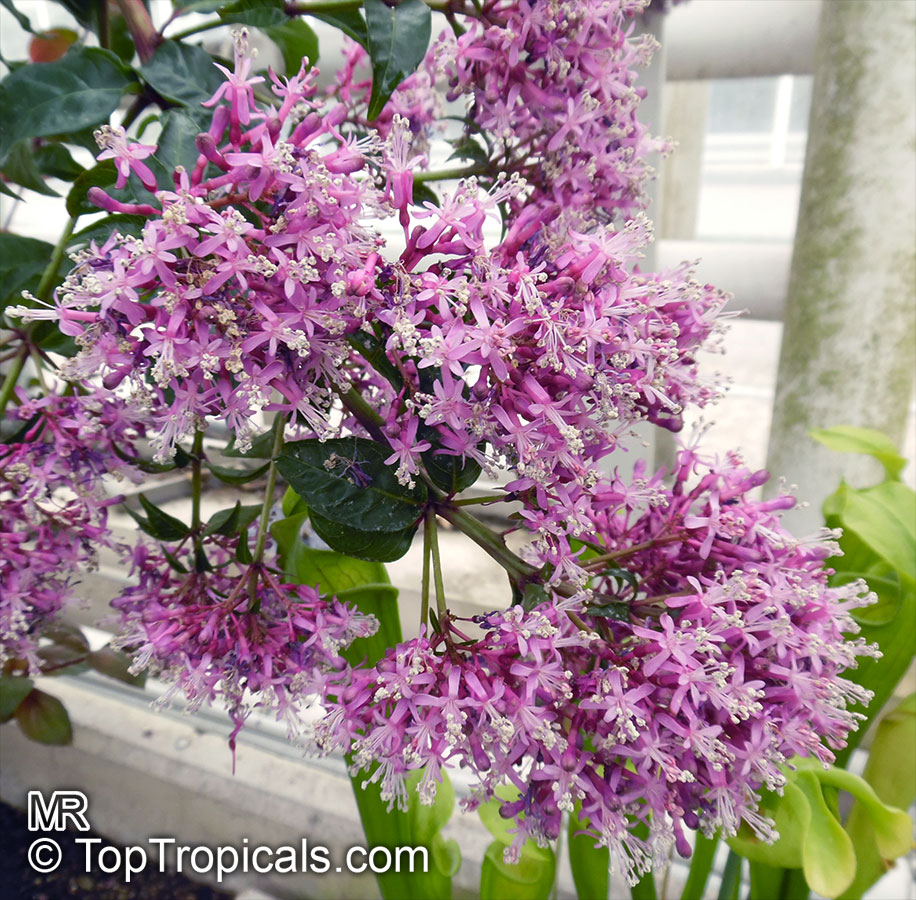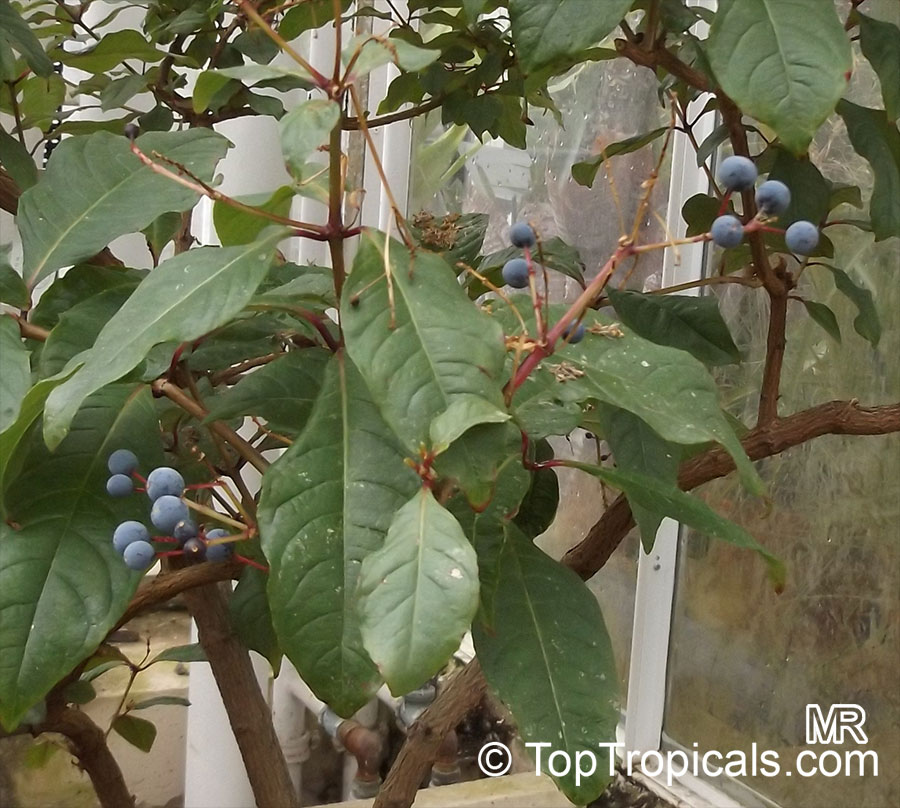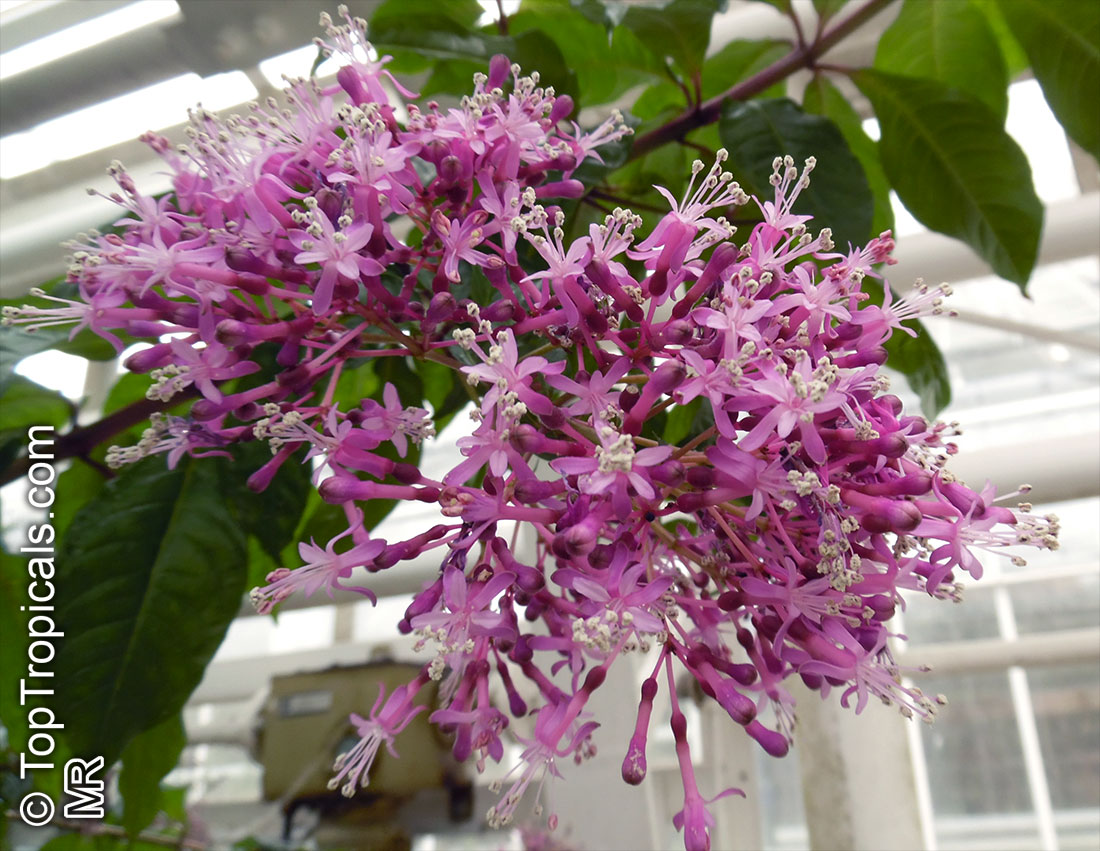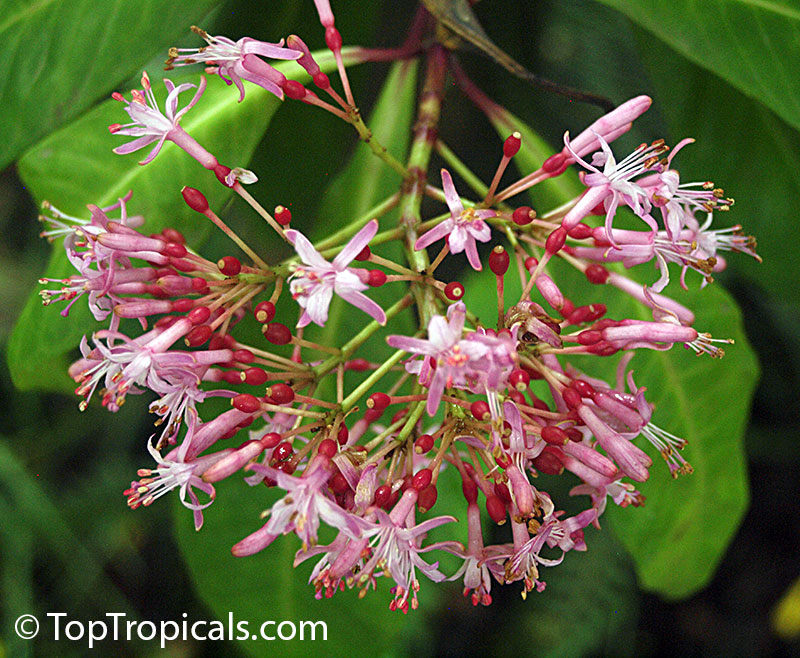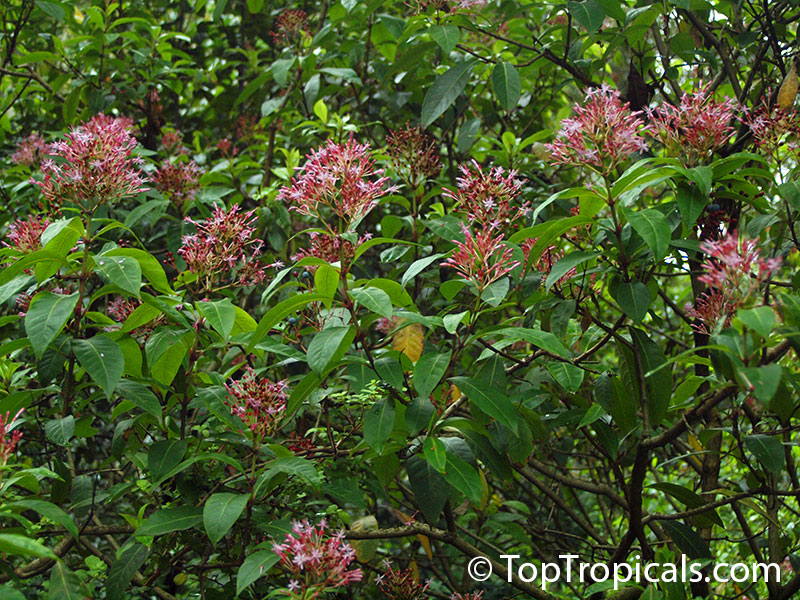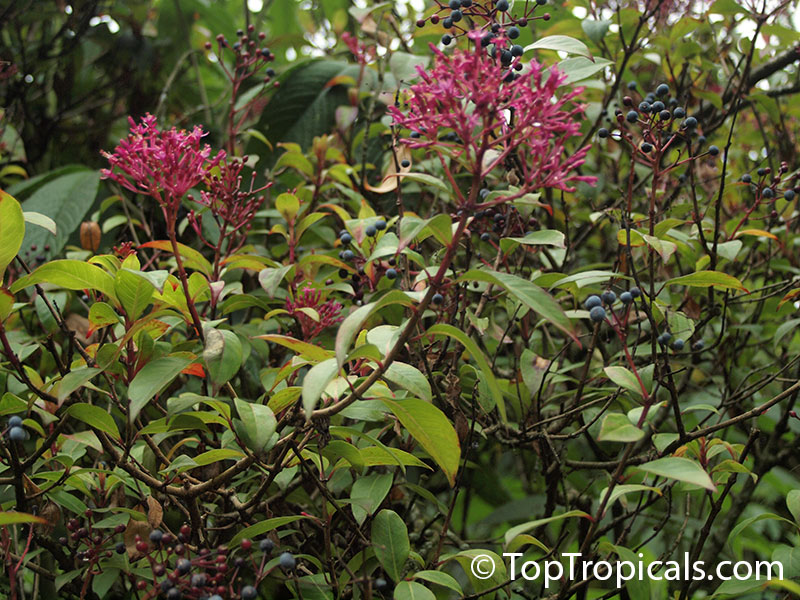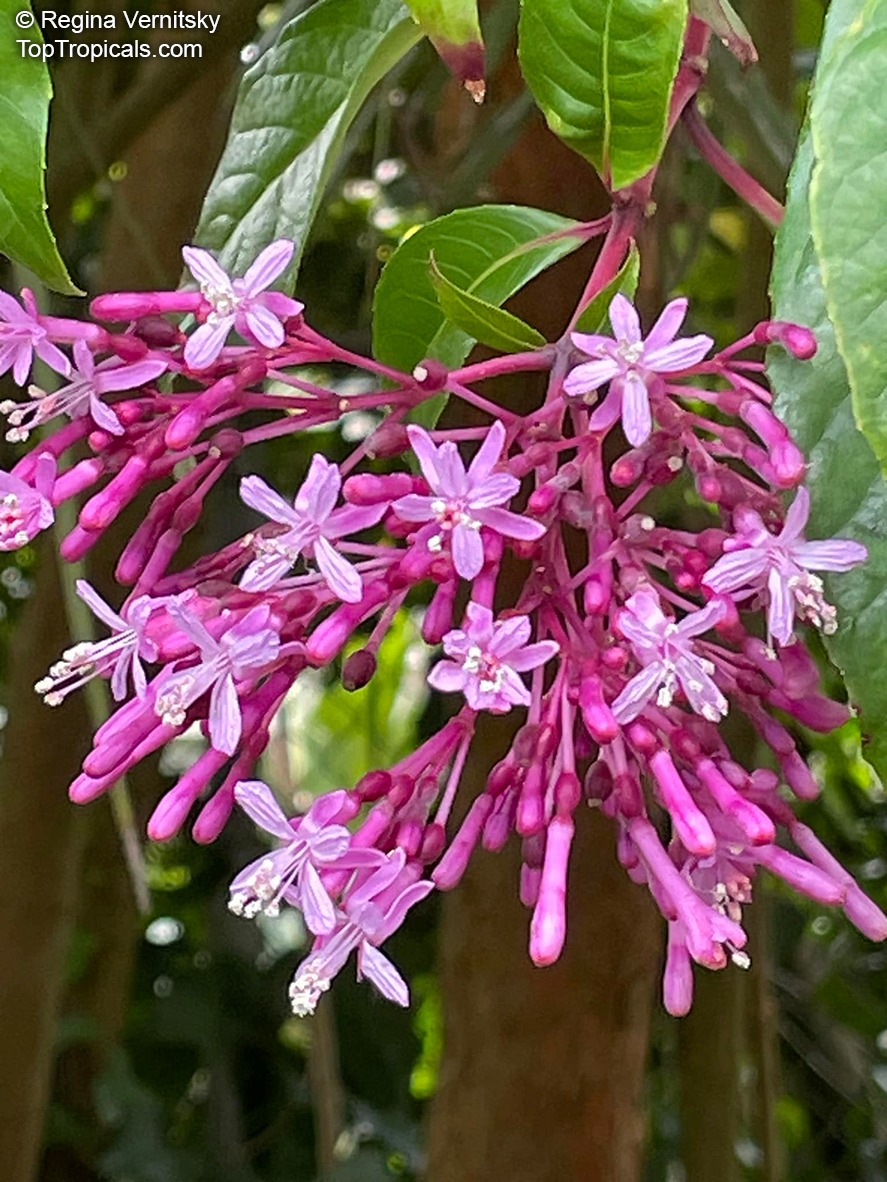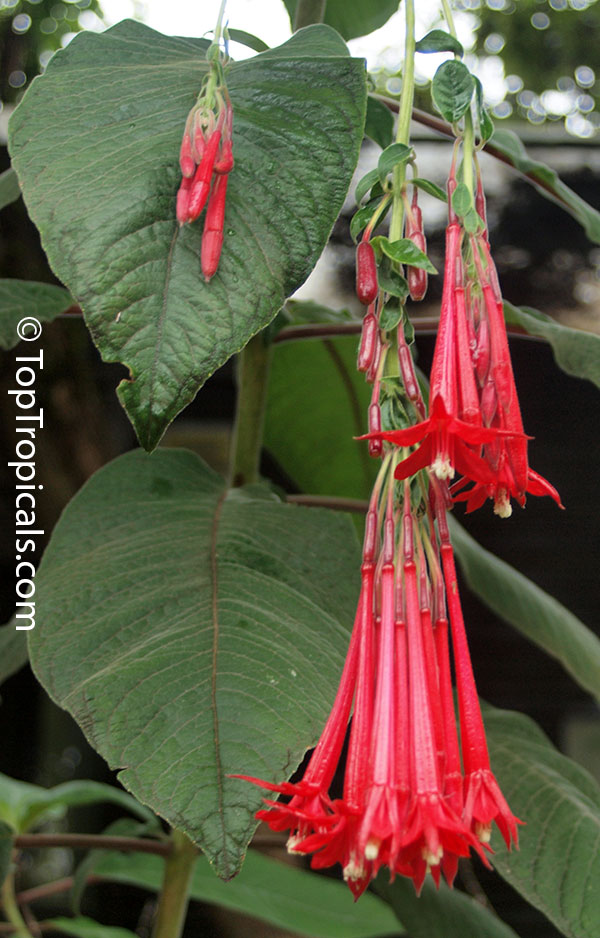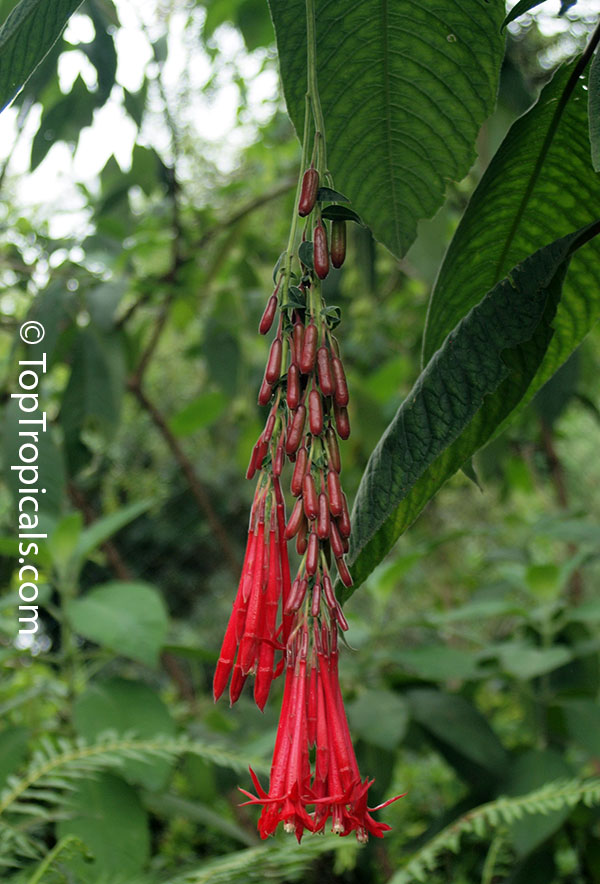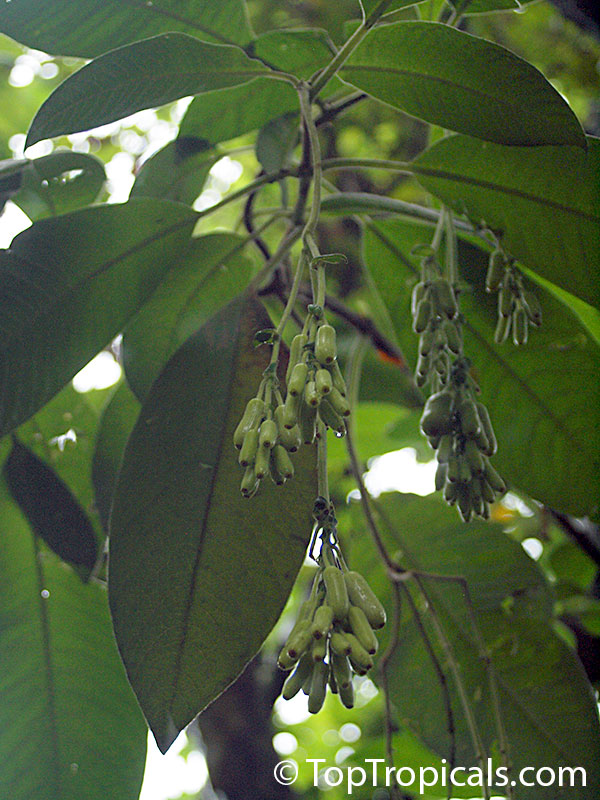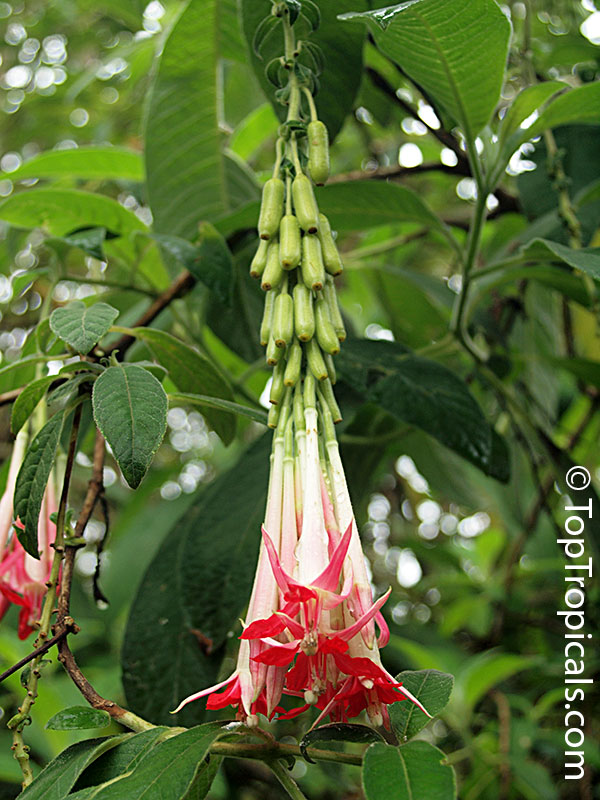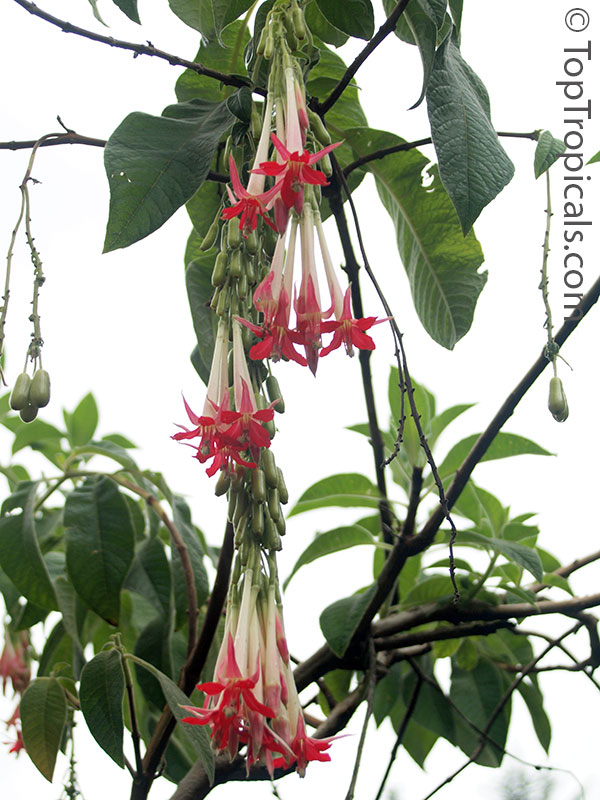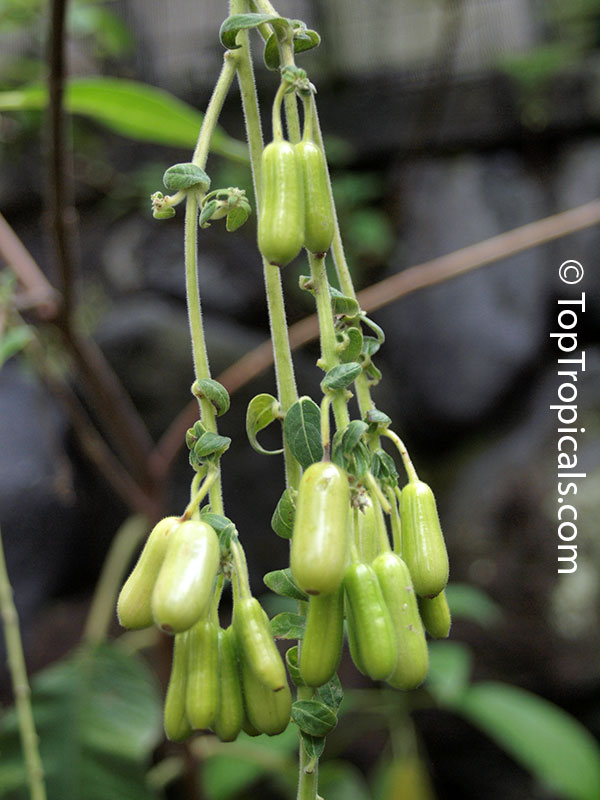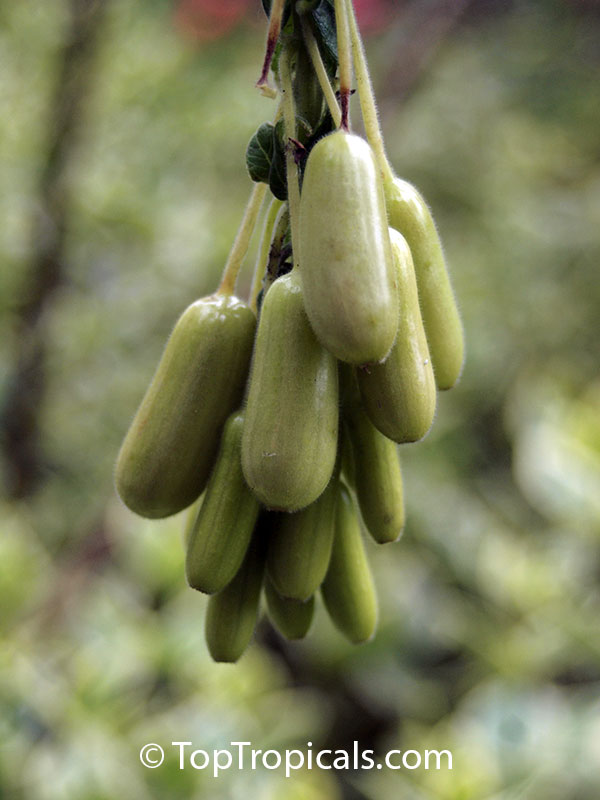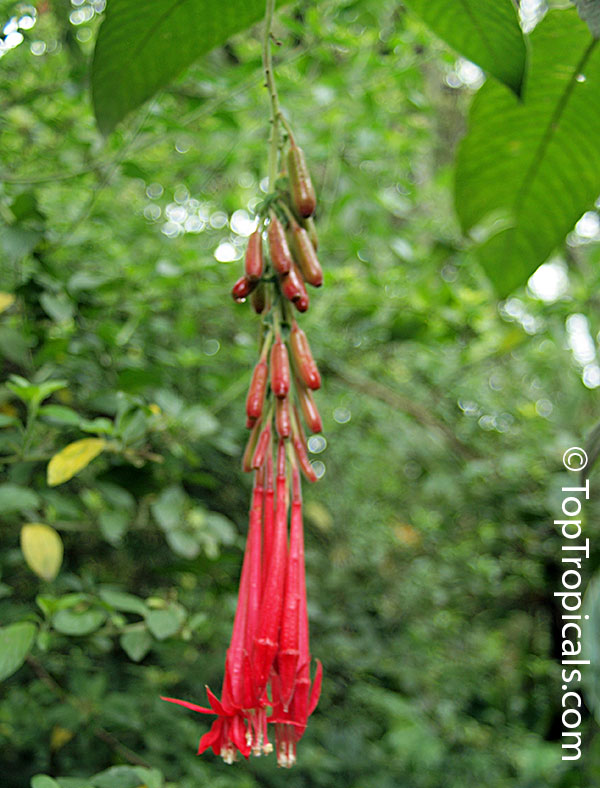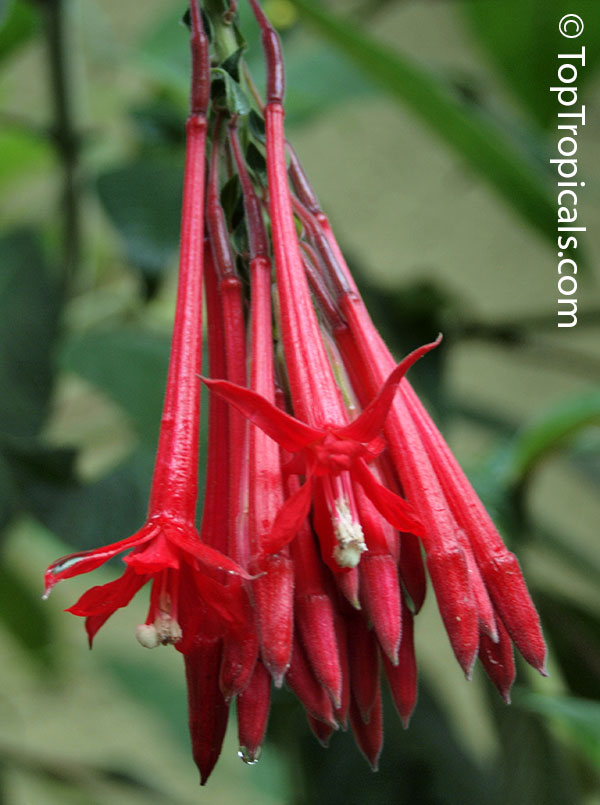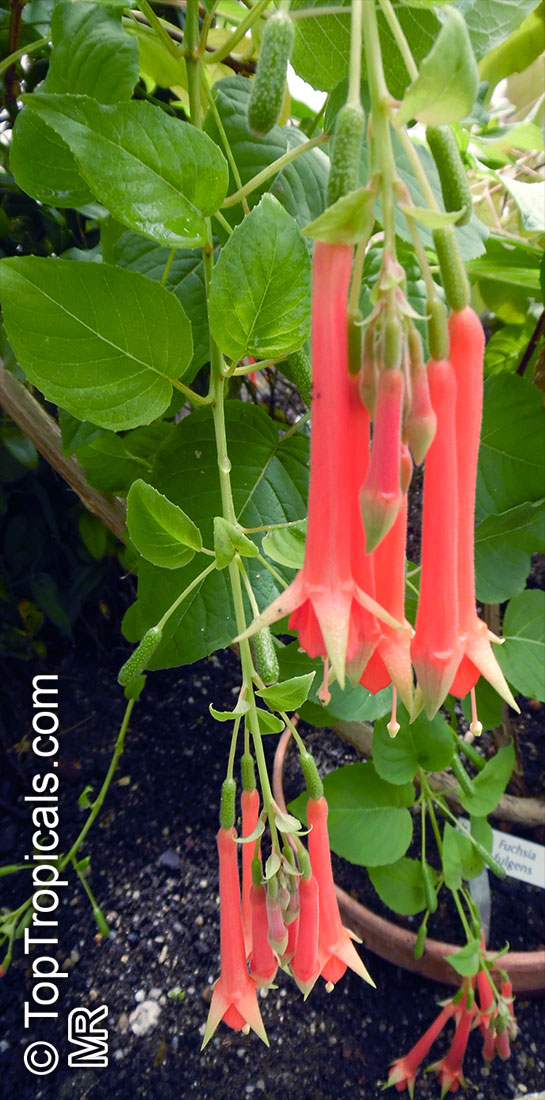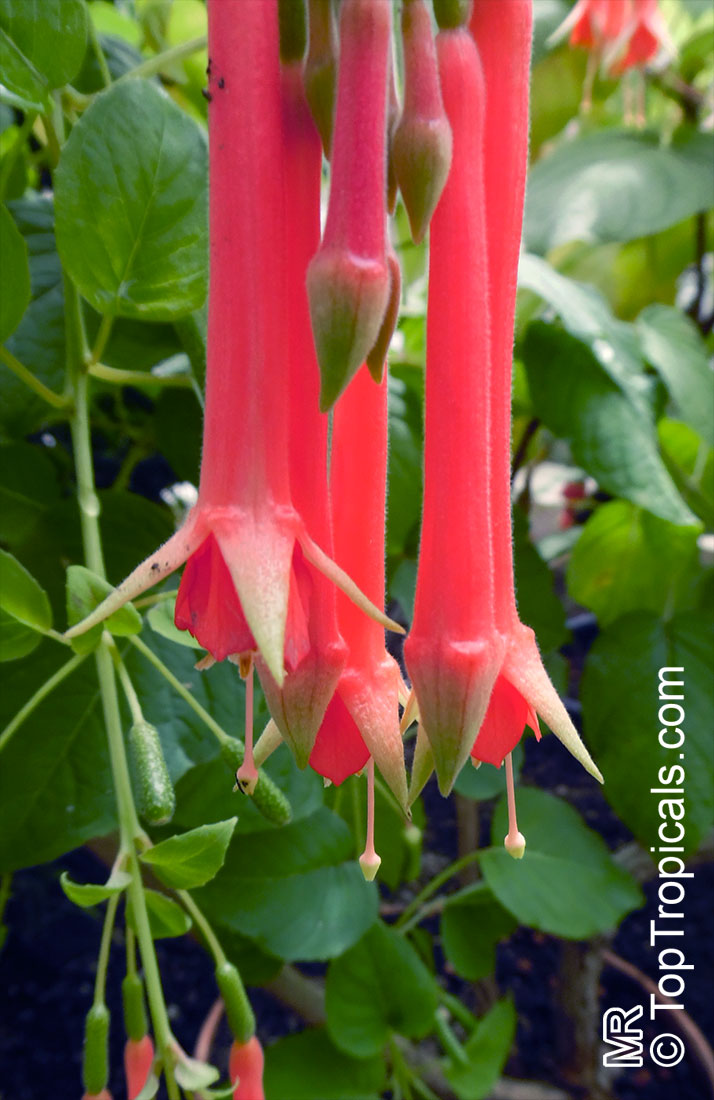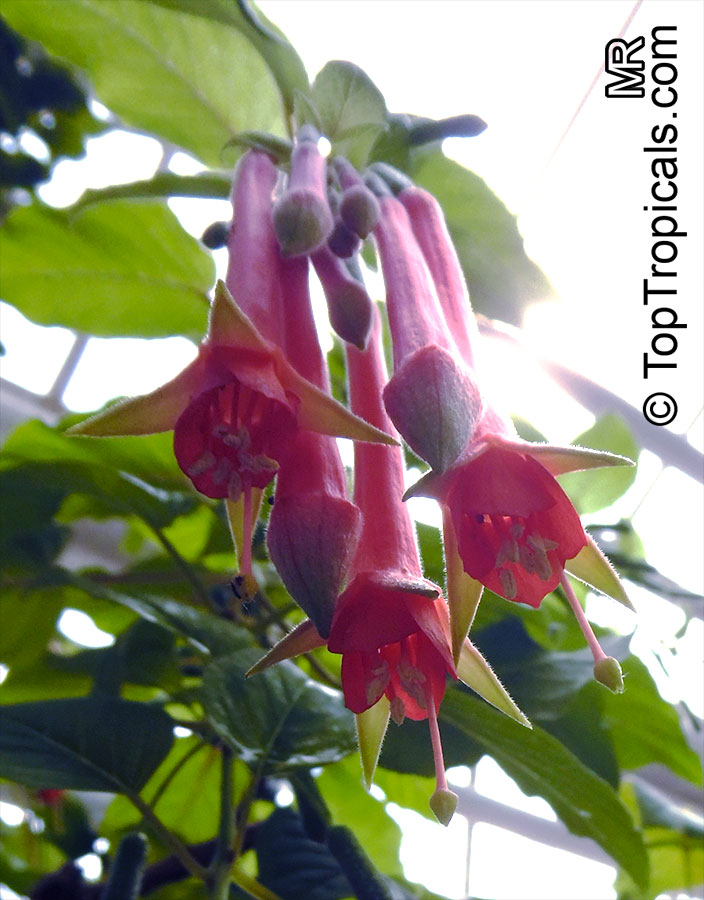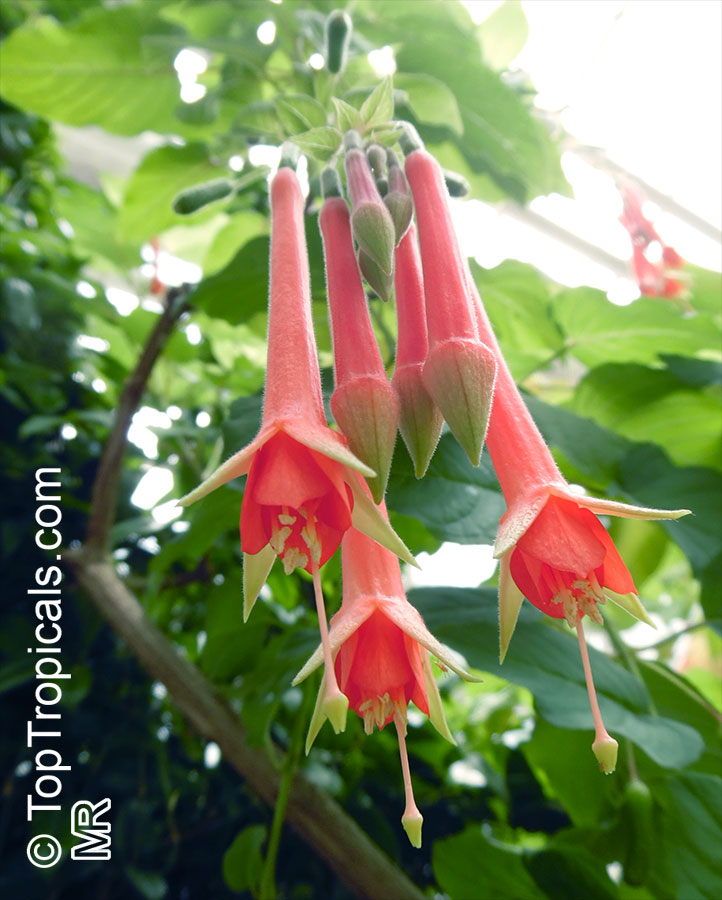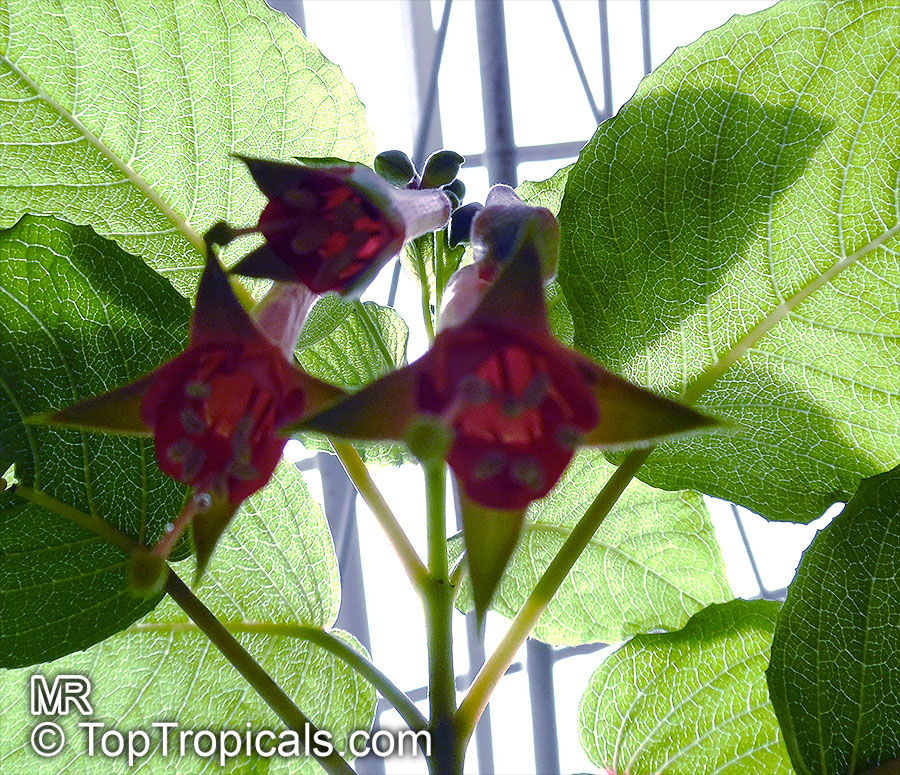Fuchsia - Plant Encyclopedia Results
Top Tropicals Plant Encyclopedia
| Number of plants found: 30 | Next | 
|
Go to page: | 1 | 2 | 3 |
Botanical name: Correa backhousiana
Common names: Velvet Correa, Backhous fuchsia
Family: Rutaceae
Origin: Tasmania





A beautiful winter flowering evergreen with pale yellow green tubular flowers from November through to spring. Attractive grey foliage. Sun, good drainage and shelter in cold areas.
This species adapts to most soils and can tolerate salt spray as well as wet ground for short periods.
Botanical name: Correa sp.
Common name: Australian fuchsia
Family: Rutaceae
Origin: Australia







Correa is a genus of about 11 species although there are many forms which are difficult to allocate to any particular species.
It is typically a small shrub to about 1 metre in height but prostrate forms and forms reaching 3 metres are also known. Leaves often have conspicuous oil glands on their surface and may be covered with short hairs. The leaves are 10 to 50mm long and oval shaped. In some forms the leaves bend back against the stem giving the appearance of water stress.
The flowers are bell shaped and up to 40mm long. They may be pale green, red, red with yellow or cream tips or a number of other variations. The flowers produce nectar and attract honey eating birds. Flowering is usually winter to early spring.
Correas are not fussy, adapting to most mild, non-tropical climates. They do best in sun or part-shade in moderately fertile, free-draining but moist soil. Some species are inclined be short lived, and plants should be replaced every 3-5 years.
Botanical names: Deppea splendens, Csapodya splendens
Common name: Golden Fuchsia
Family: Rubiaceae
Origin: Mexico






The species is now believed to be extinct in the wild. This is one of the rarest plants in cultivation today. It comes from cool cloudforests, so it prefers moderate temperatures, cool nights, and some protection from strong afternoon sun.
Botanical names: Dischidiopsis parasitica, Dischidiopsis philippinensis, Conchophyllum philippinense, Marsdenia parasitica
Common names: Fuchsia Bud, Dildo Flower
Family: Apocynaceae
Subfamily: Asclepiadoideae
Origin: Philippines






In regard to caring for Dischidiopsis parasitica, It should be kept in semi-shade, where temperatures should remain fairly gentle, with regular water and good drainage to prevent over watering. It would be better to water the soil at the base of the plant, ensuring its roots stay well in contact with the soil. During spring and summer, the vine needs moderate water with a sprinkle of compost or slow release fertilizers. During winter a well drained potting mix is required in order to prevent water retention.
For cold regions, Dischidiopsis parasitica can be grown in pots that should be placed in areas that receive full morning sunlight. Supplying enough warmth and mulch in the pot improves its growth. Water should be given only when the soil has become dry and drained. It will require watering less frequent in winter when the weather becomes colder.
Dischidiopsis parasitica produces charming, red and crimson vinous colored blooms that attract butterflies and hummingbirds. It will bloom through the whole year, so you can enjoy its beautiful flowers during any season. This beautiful plant can be perfect in your home, garden or terrace, adding a touch of color and character to it. This is truly a fascinating and beautiful plant that you won't want to miss having!
Recommended Fertilizer: SUNSHINE Robusta - Rapid Growth Booster
Botanical name: Epacris longiflora
Common names: Native Fuchsia, Fuchsia Heath
Family: Epacridaceae
Origin: Australia






E.longifolia is common in moist sandstone gullies around the central coast of New South Wales (Australia). It is typically a fairly straggly shrub comprising several long, arching branches and is usually less than a metre in height. The leaves are small and triangular in shape with a sharp point.
The flowers are narrow and tubular, up to 40mm long and occur along the branches. They contain nectar and are frequented by honey-eating birds. The typical color is red with a white tip but some variations are in cultivation such as a fully white form.
The species should be given a well drained position in semi shade but should not be allowed to dry out.
Propagation of E.longifolia is usually by cuttings of firm current season's growth. Cuttings are probably best placed into individual small pots or tubes to minimise root disturbance.
Botanical names: Epilobium canum, Zauschneria californica
Common names: California Fuchsia, Hummingbird Trumpet, Firechalice
Family: Onagraceae
Origin: California





Epilobium canum is a native of hot dry places on the west coast of North America. Here it thrives in the nutrient-deficient sun-baked soil, to which it has adapted by evolving water and starch-storing rhizomatous roots and tiny silvery leaves that reduce transpiration. These adaptations make it the perfect plant for rock and gravel gardens, raised beds or dry-stone walls, where it will offer an abundance of the most brilliant scarlet flowers from late summer to November.
Botanical name: Fuchsia arborescens
Common name: Lilac Fuchsia
Family: Onagraceae
Origin: Central America






It is a large shrub 5-10 feet tall and wide or a small tree 10-20 feet tall and wide. It is native to Central America and is grown in USDA Zone 9-11.
Fuchsia arborescens (Lilac Fuchsia) is an evergreen shrub with beautiful pink bell-shaped flowers that can provide year-round color in cool climates. Its major attraction is the dramatic looking long drooping clusters of blooms. It thrives best when given full sun and semi-shade, and requires regular watering for best results.
Planting this shrub is easy. It can be planted in the ground, or grown in containers, as it is a hardy plant. In areas where winters can get very cold, it is best to grow Fuchsia arborescens in containers and move them indoors when cold weather sets in. In mild climates, it can be planted in the garden and will remain evergreen even in cold weather.
When it comes to taking care of Fuchsia arborescens, make sure it is watered regularly since it enjoys moist, well-drained soil. The soil should be kept relatively moist in full sun, and slightly more moist in semi-shade. If you are growing the shrub in a container, it is important to ensure that the soil is light and well-draining. Moreover, consider fertilizing the plant every other month with a balanced fertilizer.
Pruning is also recommended, as it helps keep the Fuchsia arborescens healthy and helps encourage new growth. In colder climates, prune the plant back in the fall when any new growth is starting, and in areas with mild winters, prune in early spring. Make sure to prune the plant so that it is no taller than 3-4 feet, as this will help keep it growing for years to come.
Fuchsia arborescens is a great addition to any garden or home. With its beautiful flowers and easy-care requirements, it is a wonderful choice for those looking for an evergreen shrub with sensational blooms. With proper care, it can provide a stunning show of color for many years to come.
Botanical name: Fuchsia boliviana
Common name: Bolivian Fuchsia
Family: Onagraceae
Origin: Central America







This deciduous woody shrub growing up to 5-10ft tall and wide in semi-shade with regular water. It is native to Central America and has also been naturalized in many temperate and subtropical regions. This plant is widely grown as an ornamental in gardens and pots, and it also attracts many butterflies, hummingbirds, and other pollinators. The tubular flowers bloom with its vibrant colors, typically white or off-white corollas and red, crimson, or vinous sepals, are very visible when the plant is in full bloom. Beyond its ornamental uses, Fuchsia boliviana also has edible properties.
Bolivian Fuchsia is a large shrub that is best grown in USDA zones 9-11. It is noted for its showy and often colorful display of flowers that can be red, crimson, or vinous in shade. Highly attractive to butterflies, hummingbirds, and other pollinators, Bolivian Fuchsia is able to produce an edible fruit with a size of 10-26 mm long. The fruits of Bolivian Fuchsia have a red-purple hue that can be used for a variety of culinary purposes, such as jam, preserves, and smoothies. The fruit is also a good source of fiber, antioxidants, vitamins, and minerals.
In terms of plant care, Bolivian Fuchsia prefers semi-shade and regular watering, especially in warmer regions. When grown in pots, the shrub needs to be kept in an area with adequate sunlight and should be placed in an area with protection from frost in cold regions. Pruning should be done in late winter and spring, right before the new growth starts to appear. Bolivian Fuchsia should be fertilized every two months during the growing period with an all-purpose fertilizer. Regular pest control should also be done to ensure a healthy growth of the shrub.
Botanical name: Fuchsia fulgens
Common name: Fuchsia
Family: Onagraceae
Origin: Central America, Mexico








It is native to Mexico, Colombia, Ecuador, Peru and Venezuela, and is naturalized in Jamaica, Costa Rica, and Hawaii.
Fuchsia fulgens is a large shrub, growing between 5-10 ft in USDA zone 9-11. It prefers full sun or semi-shade spots, and requires regular or moderate water. The most remarkable feature of this plant are its red, crimson or vinous flowers.
Fuchsia fulgens can produce edible fruits, which are packed with nutrients. These fruits are tart and acidic in taste and highly nutritious. They contain dietary fiber, Vitamin C, B6, Iron, Phosphorous, amino acids, riboflavins and carotenoids, which are known to reduce inflammation, lower cholesterol, boost metabolism, protect against free radical damage, and increase digestion.
Preserving the vital nutrients, Fuchsia fruit can be eaten fresh, candied, canned, juiced, or used as a flavoring. The fruits can be chopped and added to smoothies or fruit salads, or used as a garnish. Fuchsia fruit can also be used to make jam, jelly and syrup.
For cold regions, Fuchsia fulgens can be grown in containers and brought indoors. A temperature range between 40 - 80 degrees Fahrenheit, moderate humidity and intense light is required for optimum growth of the Fuchsia in pots. Water on a regular basis and ensure that the soil is moist, not soggy. It should also be noted that Fuchsia should not be exposed to temperatures below 30 degrees Fahrenheit. They should be stored indoors with light and minimal watering.
| Next |  |
Use link to repeat this search:
https://toptropicals.com/cgi-bin/garden_catalog/cat.cgi?find=Fuchsia&search_op=and&keyword_op=and&language=e&number=10
&no_change_lang=1&user=tt&sale=1&first=0
